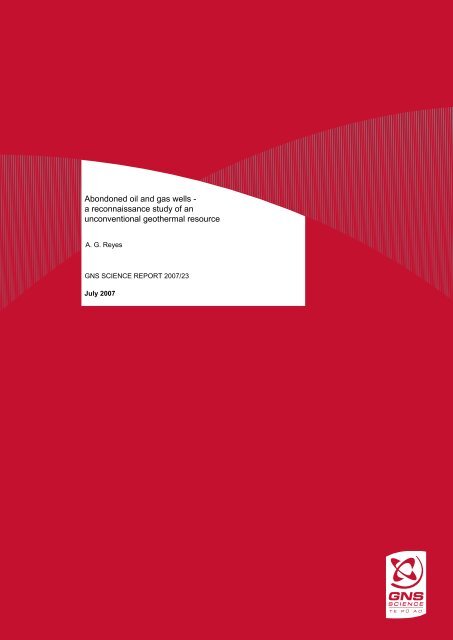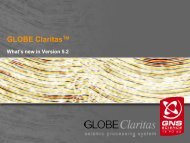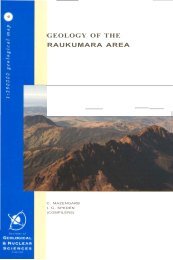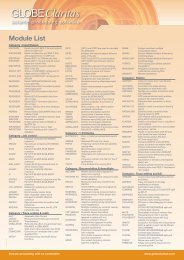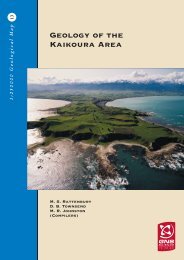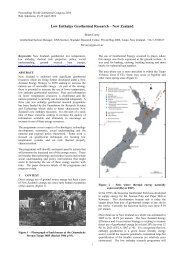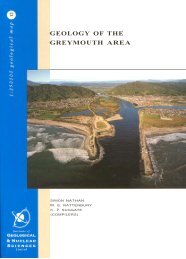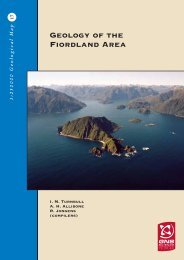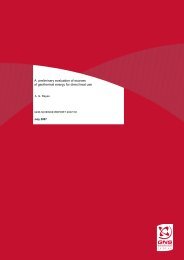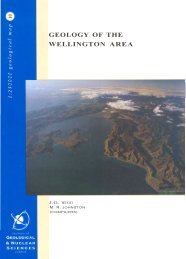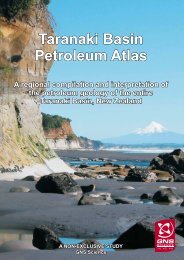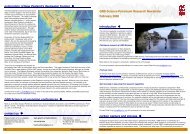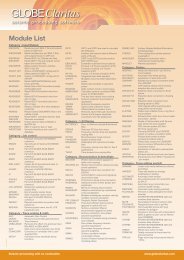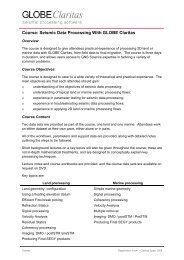GNS Science Consultancy Report 2006/0XX
GNS Science Consultancy Report 2006/0XX
GNS Science Consultancy Report 2006/0XX
Create successful ePaper yourself
Turn your PDF publications into a flip-book with our unique Google optimized e-Paper software.
Abandoned oil and gas wells -<br />
a reconnaissance study of an<br />
unconventional geothermal resource<br />
A. G. Reyes<br />
<strong>GNS</strong> <strong>Science</strong> <strong>Report</strong> 2007/23<br />
July 2007<br />
<strong>GNS</strong> <strong>Science</strong>
BIBLIOGRAPHIC REFERENCE<br />
Reyes A.G. 2007. Abandoned oil and gas wells – a reconnaissance study of an<br />
unconventional geothermal resource, <strong>GNS</strong> <strong>Science</strong> <strong>Report</strong> 2007/23 41 p.<br />
A. G. Reyes, <strong>GNS</strong> <strong>Science</strong>, 1 Fairway Drive, Avalon, PO Box 30368, Lower Hutt<br />
© Institute of Geological and Nuclear <strong>Science</strong>s Limited, 2007<br />
ISSN 1177-2425<br />
ISBN 978-0-478-09988-1
CONTENTS<br />
ABSTRACT.............................................................................................................................................iii<br />
KEYWORDS ...........................................................................................................................................iii<br />
1.0 INTRODUCTION .........................................................................................................................1<br />
1.1 Geothermal Resources in New Zealand ....................................................................... 1<br />
1.2 Objectives of Study........................................................................................................ 2<br />
2.0 ABANDONED OIL AND GAS WELLS IN OTHER COUNTRIES ..............................................4<br />
3.0 ABANDONED OIL AND GAS WELLS IN NEW ZEALAND ......................................................4<br />
3.1 Distribution and Dates of Completion............................................................................ 4<br />
3.2 Well Depths and Estimated Bottom hole Temperatures ............................................... 7<br />
3.3 Reasons for abandoning wells .................................................................................... 14<br />
4.0 HARNESSING GEOTHERMAL ENERGY FROM ABANDONED HYDROCARBON WELLS14<br />
4.1 Geothermal Potential Projections................................................................................ 14<br />
4.2 Sedimentary basins and other areas outside the Taupo Volcanic Zone..................... 16<br />
5.0 CURRENT GEOTHERMAL USE OF ABANDONED HYDROCARBON WELLS....................18<br />
6.0 INITIAL STEPS FOR USE OF WELLS ....................................................................................20<br />
7.0 RECOMMENDATIONS FOR FUTURE WORK ........................................................................23<br />
8.0 SUMMARY AND CONCLUSIONS ...........................................................................................24<br />
9.0 ACKNOWLEDGMENTS ...........................................................................................................25<br />
10.0 REFERENCES ..........................................................................................................................25<br />
FIGURES<br />
Figure 1<br />
Figure 2<br />
Temperature, depth and permeability ranges of conventional and unconventional<br />
sources of geothermal energy in New Zealand.................................................................2<br />
Distribution of conventional and unconventional geothermal resources in New<br />
Zealand..............................................................................................................................3<br />
Figure 3 Distribution of offshore and onshore abandoned wells in various hydrocarbon basins. ...5<br />
Figure 4<br />
Figure 5<br />
Figure 6<br />
Number of offshore and onshore abandoned wells in hydrocarbon basins and nonbasins<br />
of New Zealand. .....................................................................................................5<br />
Map showing the distribution of abandoned oil and gas wells with date of drilling<br />
completion and the general location of sedimentary basins..............................................6<br />
Drilled vertical depths of abandoned onshore hydrocarbon wells.....................................8<br />
Figure 7 Estimated bottom hole temperatures in abandoned onshore hydrocarbon wells. ............9<br />
Figure 8 Temperature ranges of abandoned oil and gas wells .....................................................13<br />
Figure 9<br />
Depth vs estimated bottom hole temperatures of offshore and onshore abandoned<br />
hydrocarbon wells and possible geothermal uses...........................................................14<br />
Figure 10 Depth vs formation pressure in Taranaki wells ...............................................................17<br />
Figure 11 Possible geothermal uses of abandoned hydrocarbon wells. .........................................15<br />
Figure 12<br />
Figure 13<br />
Map showing areas where temperatures >120 o C could be intersected at >3200m........17<br />
Direct heat use of 29 o C waters from well Bonithon-1, New Plymouth.............................18<br />
Figure 14 A. Bonithon-1 in New Plymouth B. Kotuku borehole forming a pseudo-warm spring. ...18<br />
<strong>GNS</strong> <strong>Science</strong> <strong>Report</strong> 2007/23<br />
i
Figure 15<br />
Figure 16<br />
Distribution of abandoned onshore hydrocarbon wells in Taranaki showing (A)<br />
vertical depths and (B) estimated bottomhole temperatures with roads and population<br />
centres. ............................................................................................................................21<br />
Abandoned hydrocarbon wells in Taranaki (squares) that may be converted for<br />
geothermal use.. ..............................................................................................................22<br />
TABLES<br />
Table 1 Number of wells within a range of temperatures .............................................................15<br />
Table 2 Potential energy from wells .............................................................................................16<br />
Table 3 Potential energy from drilling new wells in high heat flow regions ..................................22<br />
Table 4 Proposed wells for a 0.5 to 1 MWe pilot geothermal plant in Taranaki ...........................23<br />
Table 5 Main points of presentations during the Oil and Gas conference held in March <strong>2006</strong>....29<br />
Table 6 Basic well data.................................................................................................................32<br />
APPENDICES<br />
Appendix 1 Notes on the Geothermal Energy Generation in Oil and Gas Settings Conference .......27<br />
Appendix 2 Abandoned onshore hydrocarbon wells in New Zealand................................................31<br />
<strong>GNS</strong> <strong>Science</strong> <strong>Report</strong> 2007/23<br />
ii
ABSTRACT<br />
There are 349 abandoned onshore oil and gas wells in New Zealand that can potentially be<br />
harnessed for geothermal energy for direct usage of heat, power production and<br />
development as pseudo hot spring systems for tourism. Well depths range from 17 to<br />
5064m vertical. Estimated bottom hole temperatures range from ambient temperatures<br />
(about 12 to 18 o C) to 172 o C. Of these wells 65% are located in the North Island, the rest in<br />
South Island. Taranaki, the only oil and gas producing hydrocarbon basin in the country, has<br />
the largest number of abandoned oil and gas wells at 140 or about 40% of all onshore wells.<br />
The use of abandoned hydrocarbon wells for direct heat utilisation and power generation<br />
could add another 6.1 PJ to the geothermal energy potential of New Zealand. Of these 1.4<br />
PJ is for use with ground source heat pumps from 123 wells with bottomhole temperatures of<br />
1.0 INTRODUCTION<br />
With the technological advances in the last 20 years the definition of an economically viable<br />
geothermal resource has broadened to a resource that extracts heat from the rock or<br />
circulating aquifer waters at temperatures ranging from as low as 4 o C (Lund and Freeston,<br />
2001) to as high as sub-magmatic (400 o C) and from about 15m to >3500m depths. At<br />
shallow depths and temperatures of 10-35 o C heat can be harnessed from the ground or<br />
circulating water in boreholes or warm water in abandoned mines using ground source heat<br />
pumps (Lund et al, 2005). In Central and Northern Europe, for example, all heat energy<br />
stored below about 15m from the surface is considered geothermal energy (Rybach and<br />
Sanner, 2000).<br />
For some of the unconventional sources of geothermal energy, such as heat from<br />
sedimentary basins and hot dry rock (HDR), permeability or the volume of circulating fluids<br />
may be too low to economically extract heat. To increase the productivity and lifetime of<br />
these marginal geothermal sources for power generation, enhanced or engineered<br />
geothermal systems (EGS) technology may be required where, essentially, low permeability<br />
hot rock at depth is artificially fractured and fluid is introduced into the newly-fractured rock<br />
where it is heated by conduction. The heated fluids are recirculated to the surface by pumps<br />
and the heat extracted by a heat exchanger (e.g. Smith, 1983; White, 1983).<br />
1.1 GEOTHERMAL RESOURCES IN NEW ZEALAND<br />
There are conventional and non-conventional sources of geothermal energy for power<br />
generation and direct heat utilisation in New Zealand (Figure 1) ranging in temperature from<br />
about 12 to 15 o C at about 15m to as high as >330 o C at >3,500m. Power can be generated<br />
by steam turbines or by binary cycle systems using the Organic Rankine Cycle (ORC) where<br />
the working organic fluid has a low boiling temperature such as isopentane, or the Kalina<br />
Cycle which uses ammonia/water.<br />
The newest system is called the NE (Natural Energy) Engine that operates on hot and cold<br />
water and uses liquid CO 2 as a working fluid in the heat exchanger engine<br />
(www.fossil.energy.gov).<br />
Conventional sources include (1) high enthalpy hot spring systems in the Taupo Volcanic<br />
Zone (TVZ) and Ngawha in Northland some of which are now harnessed for power<br />
production, (2) waste-water from high enthalpy power-generating systems such as Wairakei,<br />
Mokai, Ohaaki-Broadlands, Kawerau, Rotokawa and Ngawha and (3) hot spring systems<br />
outside the Taupo Volcanic Zone and Ngawha and including springs in the North Island,<br />
islands in the Bay of Plenty and Hauraki Gulf and in the South Island (Figure 2).<br />
Nonconventional sources of geothermal energy include: (1) most of the TVZ outside high<br />
enthalpy geothermal systems, where thermal gradients range from 40 o C/km to >50 o C/km but<br />
permeability low, (2) 12 o C to 170 o C waters in abandoned oil and gas (hydrocarbon) wells, (3)<br />
heated waters in abandoned flooded coal and mineral mines, (4) conductive heat from<br />
shallow depths (70 mW/m 2 ) sedimentary basins, metamorphic terrain and rapidly<br />
rising regions of the country such as the Raukumara Peninsula (Mazengarb and Speden,<br />
2000) and the Southern Alps (Allis and Shi, 1995) and regions outside high heat flow<br />
regions. The location of some of the nonconventional heat sources available in New Zealand<br />
are shown in Figure 2.<br />
<strong>GNS</strong> <strong>Science</strong> <strong>Report</strong> 2007/23 1
Figure 1. Temperature, depth and permeability ranges of conventional and unconventional sources of<br />
geothermal energy in New Zealand. The temperature and depth range of abandoned oil and gas wells in New<br />
Zealand are highlighted in red.<br />
Geothermal energy in this country is associated with power generation in the Taupo Volcanic<br />
Zone and Ngawha where volcanism is recent. New Zealand has a total installed power<br />
generating capacity of 435 MWe provided by six geothermal systems in the Taupo Volcanic<br />
Zone and one at Ngawha in Northland, where a binary plant produces 9 MWe<br />
(http://www.crownminerals.govt.nz).<br />
The installed capacity for direct usage of geothermal energy in the country is 448 MWt<br />
(White, <strong>2006</strong>), 62% of which is produced from waste water and waste steam or dedicated<br />
wells in the power-generating Kawerau, Mokai, Ohaaki-Broadlands and Wairakei geothermal<br />
systems. About 170 MWt is used for bathing in more than 30 commercial swimming pools<br />
and in ad hoc holes dug for hot water at the edges of rivers or at tide level along the sea<br />
shore, space-heating, fruit irrigation, plant or fish cultivation, and health and beauty therapy.<br />
1.2 OBJECTIVES OF STUDY<br />
This is reconnaissance study on the potential of extracting geothermal energy from<br />
abandoned oil and gas wells and regions outside the Taupo Volcanic Zone (TVZ) and<br />
Ngawha. Assumptions are broad and conservative, calculations are basic.<br />
<strong>GNS</strong> <strong>Science</strong> <strong>Report</strong> 2007/23 2
Figure 2. Distribution of conventional and nonconventional geothermal resources in New Zealand including hot<br />
springs, abandoned oil and gas wells, abandoned flooded underground coal and mineral mines and stored heat in<br />
the rock. Conductive heat flow contours are from Allis et al, 1998.<br />
<strong>GNS</strong> <strong>Science</strong> <strong>Report</strong> 2007/23 3
2.0 ABANDONED OIL AND GAS WELLS IN OTHER COUNTRIES<br />
The idea of using abandoned oil and gas (hydrocarbon) wells and drilling wells in<br />
sedimentary basins to produce geothermal energy is not new. Low enthalpy geothermal<br />
resources in sedimentary basins in France have been tapped by wells for district heating<br />
since 1969. At present there are 41 plants in the Paris basin including 15 in the Aquitane<br />
basin and five in other regions producing hot water for a total of 200,000 households and<br />
supplanting about 170,000 TOE (Laplaige et al, 2000). Albania, Poland, Germany,<br />
Switzerland, USA, France and Australia are exploring the possibility of recovering heat from<br />
hydrocarbon wells (e.g., Bodvarrsson and Reistad, 1983; White, 1983; Barbacki, 2000;<br />
Schellshmidt et al, 2000; Lund et al, 2005).<br />
In the USA abandoned hydrocarbon wells, in regions of high heat flow (>75 mW/m 2 ) and<br />
sufficient water flow such as Texas and Oklahoma, are estimated to have a power<br />
generating potential at the gigawatt level (Appendix 2). Using the existing wells minimises the<br />
initial costs of geothermal power production. The main capital funding input is fitting existing<br />
wells with heat exchangers and small power plants (McKenna et al, 2005). In March <strong>2006</strong>,<br />
the Southern Methodist University in Texas held the first conference on the potential of<br />
harnessing geothermal power from abandoned hydrocarbon wells (Appendix 1).<br />
3.0 ABANDONED OIL AND GAS WELLS IN NEW ZEALAND<br />
Although the number of abandoned hydrocarbon wells in New Zealand is 50 o C in more than 150 wells<br />
drilled to depths >625m, (2) the presence of nonsaline or saline waters in most of the<br />
abandoned wells that may be discharged using artesian pressures inherent in the wells or<br />
through downhole pumps, (3) over pressuring in some wells in Taranaki (King and Thrasher,<br />
1996), the East Coast (Field et al) and Northland (Isaac et al) indicate that some wells are<br />
artesian and will flow without the need for well stimulation or hydrofracturing, (4) mud losses<br />
during drilling indicate permeability in several wells e.g., Kiakia-1/1A in the East Coast, and<br />
(4) large areas of high heat flow cover parts of the Northland, Taranaki, Wanganui and East<br />
Coast basins in the North Island and parts of the West Coast basin of the South Island<br />
(Figures 2 and 3) where the surface conductive heat flow of >70 mW/m 2 indicate thermal<br />
gradients of >33 o C/km.<br />
3.1 DISTRIBUTION AND DATES OF COMPLETION<br />
There are about 450 onshore and offshore abandoned hydrocarbon wells in New Zealand<br />
(Figure 3). Of these wells, 349 are onshore with the offshore wells drilled mostly in waters<br />
Figure 3. Distribution of offshore and onshore abandoned wells in various hydrocarbon basins (data from<br />
http://www.crownminerals.govt.nz).<br />
Figure 4. Number of offshore and onshore abandoned wells in New Zealand.<br />
<strong>GNS</strong> <strong>Science</strong> <strong>Report</strong> 2007/23 5
Figure 5. Map showing the distribution of abandoned oil and gas wells with date of drilling completion and the<br />
general location of sedimentary basins (data from http://www.crownminerals.govt.nz). Active fault lines are shown<br />
as grey lines (data from www.gns.cri.nz). Red line defines the boundaries of the Taupo Volcanic Zone.<br />
<strong>GNS</strong> <strong>Science</strong> <strong>Report</strong> 2007/23 6
The onshore wells were drilled from 1866 to 2005 with the two late-19th century ones located<br />
in Taranaki (Figure 5). The completion dates of 93 wells are unknown. Of those with known<br />
dates, 19 wells drilled from 1903-1944 are located in Taranaki, 16 in the East Coast of North<br />
Island, two in the Wanganui basin, 15 in the West Coast of South Island and one in<br />
Canterbury. These were drilled to depths of 19 to 3331m. Thirty-four wells were drilled before<br />
1970, 33 before 1980, 68 before 1990, 41 from 1990-1999 and 27 after 2000. The date of<br />
completion nearly a century ago does not preclude development. For example, Bonithon-1, a<br />
well used today for the Taranaki baths in New Plymouth was drilled in 1908. However,<br />
Bonithon-2 sited nearby and drilled nearly at the same time could not be located. Well<br />
diameters below the production casing shoe range from about 2.5” to 12”. A liner is<br />
sometimes installed and sometimes perforated. However, the liner is retrieved prior to<br />
abandoning the wells. Hence the age of the boreholes may, however, affect the degree of<br />
cave-ins in wells without liners.<br />
3.2 WELL DEPTHS AND ESTIMATED BOTTOM HOLE TEMPERATURES<br />
Abandoned wells have total vertical depths ranging from 17m to 5064m (Figure 6). Twelve of<br />
the 13 wells drilled deeper than 4000m are located in Taranaki e.g., Inglewood-1 (5061m)<br />
and Cardiff-1 (5064m). The one well deeper than 4000m outside Taranaki is located in the<br />
East Coast i.e., Rere-1 (4351m; Figure 2).<br />
Down hole temperatures, after the well had stabilised after drilling, are often not measured in<br />
hydrocarbon wells although temperatures during or just a few hours after drilling have been<br />
measured in some wells.<br />
Since stable downhole temperatures are not available for most wells, bottom hole<br />
temperatures are roughly estimated using published surface conductive heat flow data<br />
(Funnell et al, 1996; King and Thrasher, 1996; Funnell and Allis, 1997; Field et al, 1997; Allis<br />
et al, 1998, Cook et al, 1999) and converted to thermal gradient, in o C/km, using a factor of<br />
2.1 (Funnell, pers. comm., 2003) and an average surface temperature of 15 o C. In two wells,<br />
Kowai-1 and Hohonu-1, the bottom temperatures measured a few hours after drilling are<br />
higher by 8 o C and 3 o C, respectively than calculated bottomhole temperatures, i.e., 60 o C vs<br />
52 o C for Hohonu-1 and 52 o C vs 49 o C for Kowai-1. Thus calculated bottomhole temperatures<br />
are most likely minimum values. Homogenisation temperatures in the latest aqueous fluid<br />
inclusions in quartz in abandoned and active hydrocarbon wells in Taranaki are often about<br />
+10 o C of the estimated bottomhole temperatures (Reyes unpublished data, Reyes, 1998).<br />
The estimated bottomhole temperatures in the onshore abandoned hydrocarbon wells range<br />
from ambient to as high as 172 o C at 4451m in well New Plymouth-2 in Taranaki (Figures 7<br />
and 8; Table 1). About 34% of all the onshore wells (120) have bottom hole temperatures of<br />
Figure 6. Drilled vertical depths of abandoned onshore hydrocarbon wells. Grey lines are active faults<br />
(www.gns.cri.nz) and the red line defines the boundaries of the Taupo Volcanic Zone.<br />
<strong>GNS</strong> <strong>Science</strong> <strong>Report</strong> 2007/23 8
Figure 7. Estimated bottom hole temperatures in abandoned onshore hydrocarbon wells. Grey lines are active<br />
faults (www.gns.cri.nz) and the red line defines the boundaries of the Taupo Volcanic Zone.<br />
<strong>GNS</strong> <strong>Science</strong> <strong>Report</strong> 2007/23 9
Figure 8. Temperatures ranges of onshore and offshore abandoned oil and gas wells.<br />
In contrast to onshore wells about 92% of abandoned offshore wells (97 wells) have<br />
bottomhole temperatures >50 o C (Figure 8) because these are all drilled deeper than 700m.<br />
One offshore well, Clipper-1 in the Great South basin, has a calculated bottomhole<br />
temperature of nearly 185 o C at 4742m.<br />
A plot of total depth versus estimated bottom hole temperatures (Figure 9) show three<br />
onshore wells with thermal gradients higher than most wells: Rotokautuku-1 in the East<br />
Cape, Bounty-1 in the West Coast and New Plymouth-2 in Taranaki (Figures 2 and 9).<br />
Rotokautuku-1 is located in a region of active landmass uplift in the Raukumara Peninsula<br />
where the surface heat flow is high at 170 mW/m 2 believed to be caused by the advection of<br />
rising hot fluids from depth (Field et al, 1997). The thermal gradient in Rotokautuku is about<br />
80 o C/km.<br />
Well Bounty-1 in the West Coast is 3131m deep, drilled in an isolated region with a heat flow<br />
of 80 mW/m 2 heat flux (Figure 3) where the landmass is rapidly rising (Allis and Shi, 1995).<br />
Well New Plymouth-2 is drilled to 4451m in a region of 70 mW/m 2 heat flux and is located<br />
near the Pliocene to Quaternary Sugar Loaf Islands and Paritutu volcanic centres which may<br />
still possess vestigial heat at depth.<br />
The thermal gradient is about 40 o C/km in wells Bounty-1 and New Plymouth-2. The three<br />
offshore wells with the highest thermal gradients at 40-50 o C/km are wells Takapu-1 and<br />
Clipper-1 in the Great South basin and well Cook-1 in offshore Taranaki.<br />
<strong>GNS</strong> <strong>Science</strong> <strong>Report</strong> 2007/23 10
Figure 9. Depth versus estimated bottom hole temperatures of all offshore and onshore abandoned hydrocarbon wells and possible uses of geothermal fluids.<br />
<strong>GNS</strong> <strong>Science</strong> <strong>Report</strong> 2007/23 11
Table 1. Number of wells within a range of calculated bottomhole temperatures and corresponding depth ranges, in North island and South Island onshore basins and nonbasins.<br />
BHT= bottomhole temperature.<br />
Region<br />
Number of<br />
wells<br />
BHT( o C)<br />
range<br />
Depth<br />
range (m)<br />
120 o C<br />
North Island<br />
Northland 10 17-127 44-3357 5 3 1 - - 1<br />
Taranaki 140 17-172 48-5064 22 23 27 36 16 16<br />
Wanganui 15 22 – 90 295-3495 3 7 4 1 - -<br />
East Coast 62 16-150 55-4351 21 20 16 3 1 1<br />
Other areas 27 16 – 66 45-1684 17 9 1 - - -<br />
South Island<br />
West Coast 70 16-134 122-3749 43 9 13 2 1 2<br />
Canterbury 8 29 - 70 661-1696 1 4 3 - - -<br />
Southland 8 17-106 61-3131 4 - 3 - 1 -<br />
Other areas 9 17 - 81 73-2135 7 1 - 1 - -<br />
Total 349 123 76 68 43 19 20<br />
<strong>GNS</strong> <strong>Science</strong> <strong>Report</strong> 2007/23 12
Table 2. Potential energy in kW from oil and gas wells assuming flow of 4L s -1 . The conversion factor (CF) used for calculating kWt (kilowatt-thermal) is 0.7 for wells with<br />
bottomhole temperatures
3.3 REASONS FOR ABANDONING WELLS<br />
Most wells were abandoned because of low or total lack of hydrocarbon shows. The<br />
reservoirs are, instead, often saturated with fresh or saline waters and are a boon to<br />
geothermal exploitation. Others were abandoned because of drilling problems e.g., swelling<br />
clays and oil and sand bursts.<br />
Abandoned wells are plugged. In most cases liners are not installed or are pulled out upon<br />
abandonment. Hence cave-ins may occur in some older wells.<br />
Permeability is apparently present in most of the wells as indicated by the discharge of water<br />
from some wells; however the water level in the wells is unknown. In Taranaki, there is a<br />
widespread zone of over pressuring with respect to the hydrostatic gradient at >3000m (King<br />
and Thrasher, 1996) indicating that these wells may be artesian (Figure 10) and hence will<br />
flow without the need for downhole heat pumps.<br />
Figure 10. Depth versus formation pressure derived from measured values or mud weights in several Taranaki<br />
wells showing over pressuring with respect to hydrostatic pressure at about >3km depths (Figure 6.12 of King and<br />
Thrasher, 1996)<br />
4.0 HARNESSING GEOTHERMAL ENERGY FROM ABANDONED<br />
HYDROCARBON WELLS<br />
4.1 GEOTHERMAL POTENTIAL PROJECTIONS<br />
As shown in Figures 9 and 11 geothermal energy from abandoned oil and gas wells can be<br />
harnessed for direct heat using ground source heat pumps at temperatures of about 120 o C<br />
and sufficient water flow can potentially be used for power generation.<br />
There are 123 onshore wells with bottomhole temperatures
Figure 11. Possible geothermal uses of abandoned hydrocarbon wells. Grey lines are active faults<br />
(www.gns.cri.nz) and the red line defines the boundaries of the Taupo Volcanic Zone.<br />
<strong>GNS</strong> <strong>Science</strong> <strong>Report</strong> 2007/23 15
Assuming a flow of 4 L s -1 , the 206 wells with bottomhole temperatures of 30 to 120 o C can<br />
potentially produce 166,754 kWt of energy (238,220 x 0.7 = 166,754) for various direct heat<br />
uses.<br />
For the 20 wells with temperatures of 120-172 o C, the hot fluids can be used to generate<br />
power using a down hole heat pump (to enhance the flow rate and keep the resource under<br />
pressure to prevent formation of a vapour phase (Hance, 2005) and a binary cycle system. A<br />
down hole pump can be used up to about 200 o C (Hance, 2005) which is well above the<br />
highest temperatures in the abandoned wells. The total power that could be produced from<br />
these wells, assuming a flow of about 4 L s -1 and a capacity factor of 10% is 4,772 kWe<br />
(kilowatt electric) or an average of about 238 kWe per well.<br />
The use of abandoned hydrocarbon wells for direct heat utilisation and power generation<br />
could add another 6.1 PJ to the geothermal energy potential of New Zealand. Of these 1.4<br />
PJ is for use with ground source heat pumps from 123 wells with bottomhole temperatures of<br />
70 mW/m 2 (>33 o C/km), outside the Taupo<br />
Volcanic Zone, Ngawha and land administered by the Department of Conservation, covers<br />
an area of about 31,520km 2 or about 12% of the New Zealand landmass (Figure 12). In<br />
these regions, a temperature of 120 o C will be intersected at about 2,600m in Northland and<br />
the Coromandel and at least 3,200m in the rest of the North Island and in South Island<br />
(Figures 2 and 12; Table 3).<br />
Drilling new wells in these areas is dependent on accessibility (access factor) dictated by<br />
topography (e.g., slip-prone rugged Alpine slopes are problematic), land usage (e.g., national<br />
parks, private property, Maori-owned may not be accessible for drilling) and geology (e.g.<br />
proximity to faults may contribute to permeability at depth and are therefore attractive for<br />
drilling; areas best drilled for coal, hydrocarbons or precious metals may not be immediately<br />
accessible for deep drilling; regions with swelling clays or highly silicified rocks may cause<br />
drilling problems). The success rate of 0.40, used in Table 3, is the lowest success rate in<br />
exploration geothermal drilling in New Zealand, based on the percentage of geothermal wells<br />
that would successfully produce 1 MWe per five wells drilled (Barr et al, 1984).<br />
Assuming that the areas to be drilled, at 2 wells/100 km 2 , have enough permeability where<br />
heated water circulates, the temperature of extraction is 100 o C, and the drilled wells will have<br />
a flow of at least 4 L s -1 then another 21,100 kWe can be potentially produced or 0.67 PJ of<br />
geothermal energy generated (Table 3).<br />
However, before drilling new deep wells in high heat flow regions outside the Taupo Volcanic<br />
Zone and Ngawha, geothermal energy from existing abandoned hydrocarbon wells should<br />
be explored first.<br />
<strong>GNS</strong> <strong>Science</strong> <strong>Report</strong> 2007/23 16
Figure 12. Map showing areas where temperatures >120 o C could be intersected at >3200m. Blue areas are<br />
under the jurisdiction of the Department of Conservation and cannot be drilled.<br />
<strong>GNS</strong> <strong>Science</strong> <strong>Report</strong> 2007/23 17
5.0 CURRENT GEOTHERMAL USE OF ABANDONED HYDROCARBON<br />
WELLS<br />
In Taranaki, warm bicarbonate water (27 o C) from the 910m deep Bonithon-1, an abandoned<br />
hydrocarbon well drilled in 1908, is heated to 33-38 o C by gas and fed into the therapy and<br />
private pools of a commercial spa enterprise. The bore water is also bottled and sold as<br />
therapeutic mineral water (Figure 13). In Kotuku, West Coast, a leaking hydrocarbon well<br />
discharged 21 o C (ambient temperature=13 o C) effervescent bicarbonate waters at 3 kg s -1 for<br />
years and formed a pseudo warm spring pool that could be used as a tourist attraction<br />
(Figure 14). However in early <strong>2006</strong> the well ceased to flow due probably to sealing by<br />
carbonate deposition and the lowered water level caused by drought in the region. A warm<br />
spring in Lake Omapere, Northland was also originally a well. These examples show that it is<br />
possible to harness abandoned hydrocarbon wells for direct utilisation of heat or turn them<br />
into “pseudo hot springs” for tourism.<br />
Despite the projections of extracting gigawatts of geothermal power from abandoned<br />
hydrocarbon wells in the Gulf regions of the USA, only one hydrocarbon well is producing 1.5<br />
MWe of geothermal power, located in a geopressured sedimentary basin in Pleasant Bayou,<br />
Louisiana (Campbell and Hattar, 1990; Griggs, 2005).<br />
The well is 5030m deep, and intersected a leaky fault, a fault that leaks due to pressure<br />
differentials in the reservoir. Wellhead pressure is 20.7 MPa. Fluids contain 87% CH 4 . The<br />
hybrid cycle power plant is equipped with a pressure reduction turbine, with the gas providing<br />
690 kW, the binary cycle turbine 535 kW and a parasitic load of 270 kW. Problems with<br />
corrosive saline solutions were solved by using 16 gauge steel; scaling problems from<br />
130,000 mg/kg TDS waters by using inhibitors, and carbon fouling by regularly shutting and<br />
opening the plant (www.smu.edu/geothermal/Oil&Gas/Oil&Gas_SMUmeeting_summary;<br />
Appendix 1).<br />
Figure 13. Direct heat use of 29 o C waters<br />
from well Bonithon-1, New Plymouth<br />
Figure 14. Kotuku borehole forming a pseudo-warm spring<br />
(21 o C) in 2003. Flow is 3 kg/s (photo by A.G.Reyes).<br />
<strong>GNS</strong> <strong>Science</strong> <strong>Report</strong> 2007/23 18
Table 3. Drilling new wells in regions with heat flow >70 mW/m 2 where the geothermal gradient is >33 o C/km. Two wells are proposed for each 100 km 2 area. One is for<br />
production, the other for reinjection. CF= conversion factor<br />
Region<br />
Thermal<br />
gradient<br />
( o C/km)<br />
Area in<br />
km 2<br />
Temperature<br />
at depth<br />
Temperature<br />
of extraction<br />
( o C)<br />
Enthalpy<br />
(kJ/kg)<br />
Flow<br />
(kg/s)<br />
2<br />
wells/100<br />
km 2<br />
Success<br />
No. of<br />
wells for<br />
power<br />
generation<br />
kW<br />
kWe<br />
(0.1 CF)<br />
3,200m<br />
North Island 33 7,865 120 o C 100 419 4 157 0.4 31 52,727 5,273 166 0.17<br />
South<br />
Island 33 18,800 120 o C 100 419 4 376 0.4 75 126,035 12,604 398 0.40<br />
TJ<br />
PJ<br />
2,600m<br />
Coromandel 40 1,610 120 o C 100 419 4 32 0.4 6 10,793 1,079 34 0.03<br />
Northland 40 3,245 120 o C 100 419 4 65 0.4 13 21,754 2,175 69 0.07<br />
TOTAL 31,520 125 21,131 667 0.67<br />
<strong>GNS</strong> <strong>Science</strong> <strong>Report</strong> 2007/23 19
In New Zealand temperature may be present but there are many technical and non technical<br />
problems to be considered when converting oil and gas wells for geothermal extraction e.g.,<br />
1. Marginal permeability and fluid flow in a number of oil and gas wells may require<br />
hydrofracturing and/or well stimulation,<br />
2. The state of the casing and grouting jobs of wells drilled before 1980, which comprise<br />
about 45% of the onshore wells, may not be satisfactory and the wells not usable,<br />
3. Wells are filled and plugged when abandoned and will require drilling out the fills and<br />
cement before use,<br />
4. Some wells may be difficult to locate because all surface traces are covered (Funnell,<br />
pers comm. 2007),<br />
5. Oil fouling of geothermal turbines is possible when producing some wells for geothermal<br />
power,<br />
6. Liner tubings may need to be converted to slotted liners (or the tubings perforated),<br />
7. Liners have either been pulled out or not installed at all and rock may have caved-in in<br />
some wells,<br />
8. Casing corrosion, whether internally or externally induced, is probable,<br />
9. Access to the wells owned by oil companies, Maori tribes, other private owners or the<br />
New Zealand government,<br />
10. Acceptance and support of the government to the idea of converting hydrocarbon wells<br />
for geothermal use.<br />
In Taranaki cogeneration and colocation of geothermal and hydrocarbon energy sources<br />
may affect reinjection strategies because water reinjection may hasten water flooding in<br />
structurally or stratigraphically-connected hydrocarbon-bearing zones in nearby producing<br />
gas and condensate wells. Other factors that should be considered include finding methods<br />
of stimulating water flow in abandoned oil and gas wells, determining the type of binary cycle<br />
system to be used (Rankine, Kalina or NE Engine) and the feasibility of using hybrid power<br />
plant systems to cogenerate power from geothermal fluids and methane from the same well,<br />
and later, investigating EGS (Enhanced or Engineered Geothermal Systems) technology to<br />
exploit deep oil and gas wells.<br />
6.0 INITIAL STEPS FOR USE OF WELLS<br />
A pilot plant could be set up in Taranaki to demonstrate the viability of this hydrocarbon-togeothermal<br />
energy scheme. Taranaki has the most number of abandoned hydrocarbon wells<br />
with some of the highest estimated bottom hole temperatures and artesian pressures below<br />
3000m (Figures 15A and B). It is the centre of oil, gas and petrochemical production in the<br />
country. It is one of the most energy-hungry regions of the country that could benefit from<br />
cogeneration and colocation of hydrocarbon and geothermal energy sources to support its<br />
dairying, horticultural and food processing industries. Low temperature wells could be<br />
harnessed to provide heat for space heating of dairy farm buildings, milk pasteurisation,<br />
greenhouses, swimming pools and spas. Higher temperature wells (16 wells) can be used for<br />
power generation.<br />
<strong>GNS</strong> <strong>Science</strong> <strong>Report</strong> 2007/23 20
The 16 high temperature wells selected for possible geothermal power generation (Figure<br />
15) have estimated bottom hole temperatures 120 o C to 172 o C, drilled to >3100m and are<br />
mostly artesian. However four of these (with yellow crosses) were drilled prior to 1980 and<br />
the state of the casing, liners and grouting jobs is uncertain and need to be examined. All 16<br />
wells have been plugged with cement upon abandonment.<br />
For a binary cycle pilot plant with a capacity of about 200 kW five wells were selected based<br />
on their bottomhole temperatures, proximity to a population centre or an industrial complex<br />
such as Fonterra and proximity to another abandoned well that can be possibly used as a<br />
reinjection well. These wells include Tipoka-1, Te Kiri-1, Toko-1, New Plymouth-2 or<br />
Inglewood-1 (Table 4), listed according to priority, and shown in Figure 16. A downhole pump<br />
may be needed in some wells to increase or sustain fluid flow. Electricity generated from<br />
Tipoka-1 or Te Kiri-1 can be used by nearby dairy farms or Fonterra while other wells such<br />
as from Toko-1, New Plymouth-2 and Inglewood-1 may supplement electricity from the grid<br />
for Stratford, New Plymouth and Inglewood, respectively. Other wells with bottomhole<br />
temperatures >120 o C near Stratford are Wharehuia-1, Piakau-1 and Waihapa-1. Another<br />
well that could be harnessed in Inglewood is Tauteka-1. Cardiff-1, a well with a bottomhole<br />
temperature of 153 o C may be reactivated as a source of hydrocarbons and hence not<br />
included in the list.<br />
More geoscientific studies need to be done on these wells before any power harnessing<br />
could be done. The effect of drawing out large volumes of hot water on nearby activelyproducing<br />
hydrocarbon wells is not known.<br />
A<br />
B<br />
Figure 15. Distribution of abandoned onshore hydrocarbon wells in Taranaki showing (A) vertical depths and (B)<br />
estimated bottomhole temperatures with roads and population centres. Haloed wells may be used for geothermal<br />
power production.<br />
<strong>GNS</strong> <strong>Science</strong> <strong>Report</strong> 2007/23 21
Figure 16. Abandoned hydrocarbon wells in Taranaki (squares) that may be converted for geothermal use. All<br />
plotted abandoned hydrocarbon wells have estimated bottom hole temperatures (BHT) >120 o C and depths from<br />
3131 – 5064m.<br />
<strong>GNS</strong> <strong>Science</strong> <strong>Report</strong> 2007/23 22
Table 4. Proposed wells for 200 kWe pilot geothermal plant in Taranaki. Refer to Appendix 3 for well details.<br />
BHT= bottom hole temperature.<br />
Well<br />
Priority<br />
Estimated<br />
kWe<br />
Tipoka-1 1 240<br />
Te Kiri-1 2 260<br />
Toko-1 3 250<br />
New Plymouth-<br />
2<br />
4 290<br />
Inglewood-1 5 275<br />
Comments<br />
Tipoka-1 fluids (BHT= 142 o C at 4360m) can be reinjected in Tipoka-2,<br />
1.1 km away, which has BHT= 88 o C at 2504m. Power can be used by<br />
nearby dairy farms.<br />
Well (154 o C at 4710m) near dairy farms associated with Fonterra.<br />
There may be a need to drill a nearby reinjection well<br />
Fluids from Toko-1 with BHT=150 o C at 4900m can be reinjected into<br />
Toko-2 with BHT = 103 o C at 3200m, 1.2km away. There is a seal<br />
between the Mangahewa Fm in Toko-1 and the shallower Tikorangi<br />
Fm in Toko-2. Power can be used for Stratford. Other wells near<br />
Stratford that can be used for power generation are: Wharehuia-1<br />
(114 o C at 3595m) with fluids reinjected into Piakau-1 1.0km away or<br />
Waihapa-1 (144 o C at 4942m) using Waihapa-2, 1.8km away, as a<br />
reinjection well<br />
Highest BHT of all onshore wells at 172 o C; located in middle of New<br />
Plymouth. Fluids can be reinjected in numerous adjacent abandoned<br />
wells. This was drilled before 1980 and the state of the casings and<br />
grouts is unknown.<br />
BHT= 164 o C at 5061m. This was drilled before 1980. There may be a<br />
need to drill a nearby reinjection well. The nearest abandoned well<br />
that could be used for reinjection is Ngatoro-1 about 2.1km away.<br />
Power can be used by Inglewood. Another well near Inglewood is<br />
Manganui-1 (131 o C at 3753m) with Tauteka-1, 830m away, as a<br />
reinjection well<br />
7.0 RECOMMENDATIONS FOR FUTURE WORK<br />
This is merely a reconnaissance study whose main goal is to present an idea and the basic<br />
data of wells that could be used for geothermal energy purposes. Before any wells could be<br />
used the following studies should be done:<br />
1. Review all literature on wells regarding water reservoirs, fault and stratigraphic<br />
permeability, stratigraphic connectivity among abandoned and actively-producing wells,<br />
downhole pressure and temperature measurements and geology.<br />
2. Determine the state of the casing/tubings, liners and cementing jobs of selected wells.<br />
3. Determine the corrosion state of the well pipes.<br />
4. Measure downhole temperatures of selected wells.<br />
5. Determine flow rates of well discharges and methods of stimulating water flow.<br />
6. Find out if hydrofracturing is necessary or possible to enhance permeability.<br />
7. Find out the maximum working temperatures of down hole pumps.<br />
8. Determine fluid discharge chemistry to find out if a hybrid plants can be used to tap both<br />
gas and geothermal fluids, predict fouling problems to the plant, determine ways of<br />
disposing well fluids (use a reinjection well or dispose fluids into the waterways).<br />
9. Determine fluid pathways and temperatures using petrological and geochemical<br />
methods.<br />
<strong>GNS</strong> <strong>Science</strong> <strong>Report</strong> 2007/23 23
10. Determine how geothermal production will affect the hydrocarbon reservoirs.<br />
11. Study the economic viability of converting extant hydrocarbon wells for geothermal direct<br />
heat use or for power production.<br />
8.0 SUMMARY AND CONCLUSIONS<br />
The 349 abandoned onshore oil and gas wells in New Zealand have total vertical depths of<br />
17 to 5064m and estimated bottom hole temperatures ranging from ambient temperatures<br />
(about 12 to 18 o C) to 172 o C. Of these wells 65% are located in the North Island, the rest in<br />
South Island. Taranaki, the only oil and gas producing hydrocarbon basin in the country, has<br />
the largest number of abandoned oil and gas wells at 140 or about 40% of all onshore wells<br />
and also contains 16 of the 20 wells with bottomhole temperatures >120 o C.<br />
Thus the use of abandoned hydrocarbon wells for direct heat utilisation and power<br />
generation could add another 6.1 PJ to the geothermal energy potential of New Zealand. Of<br />
these 1.4 PJ is for use with ground source heat pumps from 123 wells with bottomhole<br />
temperatures of 120 o C and include, with decreasing priority,<br />
Tipoka-1, Te Kiri-1, Toko-1, New Plymouth-2 or Inglewood-1. The selected wells are either<br />
near dairy farms or an industrial complex like Fonterra or within a population centre such as<br />
Stratford, new Plymouth and Inglewood. Three of the sites are within a 1.8 km radius from<br />
another abandoned well, but with lower temperatures, that can be used for reinjection. Well<br />
Inglewood-1, however, is 2.1 km from the nearest abandoned well and a reinjection may<br />
need to be drilled nearer the well and there is no nearby well for Te Kiri-1.<br />
New wells in high heat flow regions of the country, outside the Taupo Volcanic Zone,<br />
Ngawha and Department of Conservation land, may provide another 0.67 PJ of energy<br />
assuming production of energy from waters extracted at 100 o C and a flow of about 4 L s -1 .<br />
However, these will only be drilled once the viability of geothermal power outside the Taupo<br />
Volcanic Zone and Ngawha have been proven by harnessing geothermal energy from<br />
abandoned hydrocarbon wells.<br />
The requisite temperature may be present in abandoned hydrocarbon wells for a wide range<br />
of geothermal energy uses but there are many geoscientific, technical and non technical<br />
problems to be considered before oil and gas wells can be used for geothermal power<br />
generation or cogeneration of geothermal and hydrocarbon energy. However New Zealand<br />
has the available expertise in the geothermal and oil and gas industries and access to the<br />
requisite technology, making this scheme of converting old hydrocarbon wells for geothermal<br />
use viable.<br />
<strong>GNS</strong> <strong>Science</strong> <strong>Report</strong> 2007/23 24
Converting at least a pair of abandoned hydrocarbon wells (one for production the other for<br />
reinjection) in Taranaki for use in a 200 kWe pilot plant may prove the viability of this<br />
scheme.<br />
9.0 ACKNOWLEDGMENTS<br />
Thank you to D. Darby and E. Mroczek for reviewing the report whose comments and<br />
suggestions have contributed to the improvement of the report. Discussions with D. Darby, E<br />
Mroczek, and J. Callan and speakers of the conference on Geothermal Energy Generation in<br />
Oil and Gas Settings Conference held in the Southern Methodist University, Texas in 13-14<br />
March <strong>2006</strong> have helped in writing this report. Thank you to K. Hunt for her expert word<br />
processing.<br />
10.0 REFERENCES<br />
Allis R G and Shi Y (1995) New insights to temperature and pressure beneath the central<br />
southern Alps, New Zealand. NZ J Geol Geophysics, 38, 585-592.<br />
Allis R G, Funnell R and Zhan X (1998) From basins to mountains and back again: NZ basin<br />
evolution since 10 Ma. Proceedings 9 th International Symposium on Water-Rock<br />
Interaction, Taupo New Zealand, 3-7.<br />
Barbacki A (2000) The use of abandoned oil and gas wells in Poland for recovering<br />
geothermal heat. Proceedings World Geothermal Congress 2000, Kyushu Japan,<br />
3361-3365.<br />
Barr H, Grant M A and Mclachlan R (1984) Proving and development of geothermal fields,<br />
DSIR <strong>Report</strong> 116, Wellington New Zealand.<br />
Barry J M, Duff S W and MacFarlan D A B (1994) Coal resources of New Zealand. Coal<br />
report series CR3132, NZ Ministry of Commerce, 73 p.<br />
Bodvarrsson G and Reistad G M (1983) Forced geoheat recovery for moderate temperature<br />
uses. J Volcanol and Geoth Res, 15, 247-267.<br />
Campbell R G and Hattar M M (1990) Operation of a geopressured hybrid power system at<br />
Pleasant Bayou. Proceedings Energy Conversion Engineering Conference, 1990,<br />
IECEC-90 25 th Intersociety, 91-101.<br />
Cook R A, Sutherland, R, Zhu H and others (1999) Cretaceous-Cenozoic geology and<br />
petroleum systems of the Great South basin, New Zealand. Institute of Geological<br />
and Nuclear <strong>Science</strong>s Monograph 20, Lower Hutt New Zealand, 188 p.<br />
Dunstall M (2005) 2000-2005 New Zealand country update. Proceedings World Geothermal<br />
Congress 2005, Turkey.<br />
Field B D, Uruski C I and others (1997) Cretaceous-Cenozoic geology and petroleum<br />
systems of the East Coast region, New Zealand. Institute of Geological and Nuclear<br />
<strong>Science</strong>s Monograph 19, Lower Hutt New Zealand, 301 p.<br />
Funnell R and Allis R G (1997) Hydrocarbon maturation potential of offshore Canterbury and<br />
Great South basins. Proceedings New Zealand Petroleum Conference, 22-30.<br />
Funnell R, Chapman D, Allis R and Armstrong P (1996) Thermal state of the Taranaki Basin,<br />
New Zealand. JGR, V 101 (B11), 25197-25215.<br />
Griggs J (2005) A reevaluation of geopressured-geothermal aquifers as an energy source.<br />
Proceedings 30 th workshop on geothermal reservoir engineering, Stanford University,<br />
California.<br />
Hance C N (2005) Factors affecting costs of geothermal power development. Geothermal<br />
Energy Association for the US Department of Energy, 61 p.<br />
<strong>GNS</strong> <strong>Science</strong> <strong>Report</strong> 2007/23 25
Isaac M J, Herzer R H, Brook F J and Hayward B W (1994) Cretaceous and Cenozoic<br />
sedimentary basins of Northland, New Zealand, Inst. of Geol and Nuclear <strong>Science</strong>s<br />
Monograph 8, 203 p.<br />
King P R and Thrasher G P (1996) Cretaceous-Cenozoic geology and petroleum systems of<br />
the Taranaki Basin, New Zealand. Institute of Geological and Nuclear <strong>Science</strong>s<br />
Monograph 13, Lower Hutt New Zealand, 243 p.<br />
Klein C W, Lovekin J W and Sanyal S K (2004) New geothermal site identification and<br />
qualification. GeothermEx Inc. report.<br />
Laplaige P, Jaudin F, Desplan A and Demange J (2000) the French geothermal experience<br />
review and perspectives. Proceedings World Geothermal Congress 2000, Kyushu<br />
Japan, 283-294.<br />
Lund, J, Freeston D H and Boyd T L (2005) World-wide direct uses of geothermal energy<br />
2005. Proceedings World Geothermal Congress 2005, Turkey.<br />
Mazengarb C and Speden I G (2000) Geology of the Raukumara area. Institute of Geological<br />
and Nuclear <strong>Science</strong>s 1:250,000 Geological Map 6.<br />
Mckenna J, Blackwell D, Moyes C and Patterson D P (2005) Geothermal electric power<br />
supply possible from Gulf Coast, midcontinent oil field waters. Oil and Gas Journal,<br />
34-39.<br />
Rybach L and Sanner B (2000) Ground source heat pump systems, the European<br />
experience. GHC Bull, 16-26.<br />
Reyes A G (2001) Mineral alteration in a low-enthalpy hydrocarbon well, Taranaki, New<br />
Zealand. Proceedings 23 rd New Zealand Geothermal Workshop.<br />
Schellschmidt R, Clauser C, and Sanner B (2000) Geothermal energy use in Germany at the<br />
turn of the millenium. Proceedings World Geothermal Congress 2000, Kyushu Japan,<br />
427-432.<br />
Smith M (1983) A history of hot dry rock geothermal energy systems. J Volcanol and Geoth<br />
Res, 15, 1-20.<br />
White A A L (1983) Sedimentary formations as sources of geothermal heat. J Volcanol and<br />
Geoth Res, 15, 269-284.<br />
Websites<br />
http://www.crownminerals.govt.nz<br />
www.fossil.energy.gov<br />
<strong>GNS</strong> <strong>Science</strong> <strong>Report</strong> 2007/23 26
APPENDIX 1<br />
NOTES ON THE GEOTHERMAL<br />
ENERGY GENERATION IN OIL AND<br />
GAS SETTINGS CONFERENCE<br />
<strong>GNS</strong> <strong>Science</strong> <strong>Report</strong> 2007/23 27
APPENDIX 1 NOTES ON THE GEOTHERMAL ENERGY GENERATION IN OIL<br />
AND GAS SETTINGS CONFERENCE<br />
The conference was held in March <strong>2006</strong> at the Southern Methodist University (SMU) in<br />
Texas, organised by D. Blackwell. The main point of the conference is the enormous<br />
potential of oil and gas settings in providing geothermal power. What oil and gas operators<br />
view as the death of a fossil fuel system is viewed as the source of another energy by the<br />
geothermal industry that also has the blessings of the environmentally conscious population.<br />
Talks were about 75% technical, 25% laws and regulations affecting geothermal and oil and<br />
gas systems in the USA (main points of talks are in Table 4).<br />
The most interesting talks and posters were centred on the heat flow map of the USA that<br />
SMU had published at the AAPG. The map making was led by David Blackwell of SMU. One<br />
of the main offshoots of this map is the reestimation of the geothermal potential of the USA<br />
using oil and gas wells and EGS technology (EGS= Enhanced or Engineered Geothermal<br />
Systems). The total conservative geothermal potential of the USA is 43,617,976 MWe. At<br />
present geothermal provides 8900 MWe of power to 24 countries world-wide.<br />
The oil and gas operators view water flooding as the end of the field whereas geothermal<br />
operators see this phenomenon as the start of a new source of energy. Some of the<br />
problems in harnessing geothermal energy from oil and gas wells are not technical but<br />
include the lack of communication between people in the oil and gas and geothermal<br />
industries and the lack of overt support from the federal government. During the meeting the<br />
discussion panel decided to write a one-page white paper report on “Geothermal Energy<br />
Generation in Oil and gas Settings”, to be submitted to the government and oil and gas<br />
operators. Interestingly, the convenors sent nearly 15,000 invitations to oil and gas operators<br />
and technical people, government officials and the media to attend this conference (which is<br />
the first in the world and quite important for the future energy outlook of the USA, at least) but<br />
there were only 90 attendees,
Table 5. Main points of presentations during the Oil and Gas conference held in March <strong>2006</strong>.<br />
Speaker Company/Agency Topic Main Points of Talk<br />
Ray<br />
LaSala<br />
Susan<br />
Petty<br />
Dub<br />
Taylor<br />
Louis<br />
Capuano<br />
Paul<br />
Thomsen<br />
David<br />
Blackwell<br />
Will<br />
Gosnold<br />
US DOE Geothermal<br />
Technologies<br />
Black Mountain Technology<br />
State Energy Conservation Office<br />
(SECO)- Texas Renewable<br />
Program<br />
ThermaSource, Inc<br />
ORMAT<br />
Southern Methodist University<br />
University of North Dakota, Dept<br />
of Geol & Geol. Engg<br />
Dept. of Energy Geothermal<br />
Focus<br />
US <strong>2006</strong> Enhanced<br />
Geothermal System<br />
Resource Evaluation<br />
Texas Renewable Program<br />
and Demonstration Sites<br />
Comparison between<br />
geothermal and oil & gas<br />
drilling<br />
Modular binary power<br />
generators<br />
Geothermal resources in<br />
sedimentary basins<br />
Northern Great Plains<br />
geothermal resources<br />
Berni Karl Chena Hot Springs Resort Geothermal electrical<br />
application in Alaska<br />
Dick<br />
Benoit<br />
Mike<br />
Shook<br />
Prentice<br />
Creel<br />
Sustainable Solutions<br />
Chevron-Texaco<br />
Halliburton<br />
Scaling and corrosion<br />
abatement<br />
Heat extraction from<br />
sedimentary formations<br />
Well integrity to extend a<br />
well’s life<br />
DOE’s geothermal budget for 2007: $0.00 yet they plan to have 40,000 MWe from<br />
geothermal by 2040 at 80 o C including overpressured<br />
systems: 43,617,976 MWe @20% recovery, using ORC and conventional steam<br />
turbines (lots of very conservative assumptions in calculations)<br />
Texas is the 5 th largest energy user in the world and most of the energy sources are<br />
from fossil fuels.<br />
Major differences: temperature, production pressures, rock formation characteristics,<br />
production rates and types of discharge fluids; tubings used in oil & gas, slotted liners<br />
in geothermal<br />
Binary and flash steam turbines, modular (mainly an advertising spiel- presentation on<br />
ORMAT data most people in the geothermal industry already know). Turbine<br />
efficiency is now 88%.<br />
Discussed what factors SMU considered in making heat flow map of USA (AAPG<br />
publication) e.g., used several correction factors to estimate BHT’s at various depths.<br />
Scenarios for development of sedimentary basins: co-production of fluids,<br />
geopressured fluids, sedimentary EGS (enhanced geothermal systems)<br />
Anomalously high temperatures in this region partly due to blanketing effect of shales<br />
and heat advection in regional groundwater flow system.<br />
74 o C waters from well used to provide electricity for resort using ORC system of<br />
United Technologies where Carrier air conditioners are reengineered as reverse<br />
chillers (smallest module is 200kw). Used thermal waters are cascaded for use in<br />
greenhouse, space heating and an ice house (Kalina cycle)<br />
Main problems in oil & gas wells that would be used as geothermal wells would be<br />
carbonate scaling and corrosion due to hyper saline fluids<br />
Modelled several scenarios on how heat can be extracted from oil & gas wells: best<br />
case is a vertical well dual doublet with a circulation rate of 6.31 kg/s. Inlet T (T of<br />
water being fed into well)= 27 o C, fed water heated to 203 o C. There is a need to<br />
balance circulation rate and temperatures for optimum energy efficiency- best model<br />
is use of horizontal wells but modelling study still ongoing. Geothermal production<br />
from mature watered-out oil & gas fields and from fields with on-going water-flooding<br />
Use of zoned seal foam cement extolled because of its high strength, high viscosity<br />
and excellent displacement properties, resulting to better cementing jobs- the key to<br />
long lives of wells<br />
<strong>GNS</strong> <strong>Science</strong> <strong>Report</strong> 2007/23 29
Speaker Company/Agency Topic Main Points of Talk<br />
Tim Smith Element Markets LP Renewable Energy Credits<br />
(REC’s) for the Gulf Coast<br />
States<br />
Greg<br />
Mines<br />
Jason<br />
McKenna<br />
Richard<br />
Erdlac<br />
7 posters<br />
presented<br />
Richard<br />
Campbell<br />
Joel<br />
Renner<br />
Richard<br />
Erdlac<br />
Mark<br />
Millican<br />
Susan<br />
Petty<br />
Idaho National laboratory<br />
Engineer research and<br />
Development Center US Army<br />
Corps of Engineers<br />
University of Texas Permian<br />
Basin CEED<br />
TIC- The Industrial Company<br />
Idaho National Laboratory<br />
UT Permian Basin CEED<br />
Rocky Mountain Oilfield Testing<br />
Center<br />
Black Mountain Technology<br />
Contributors to the cost of<br />
geothermal power<br />
production<br />
Geothermal potential in<br />
military facilities<br />
Texas geothermal energy: a<br />
focus on Permian basin and<br />
Trans-Pecos regions<br />
Results of the demonstration<br />
power plant on the Pleasant<br />
Bayou geopressured<br />
resource<br />
Pleasant Bayou, TX<br />
geopressured geothermal<br />
reservoir<br />
Constraints and best use<br />
practices: the importance of<br />
Texas geothermal electrical<br />
energy production<br />
Tea Pot Dome Case Study,<br />
Wyoming<br />
Geothermal power<br />
generation potential- Poplar<br />
Dome, MT<br />
Regulations in the USA<br />
1REC= 1MWh of energy<br />
Regulations in the USA<br />
Water/oil ratio cut (water-flooding) = 95%. Thinking of using flooded oil & gas systems<br />
in Iraq to increase country’s energy source base<br />
Most interesting poster is a new system for harnessing energy using the movement of<br />
a magnet in a tube, by either a temperature or pressure gradient- still in development<br />
stage (Larry Shultz of Encore Clean Energy)<br />
Well has WHP= 20.7 MPa. Fluids have 87% CH 4 . A hybrid cycle power plant is used,<br />
equipped with a pressure reduction turbine. Gas= 690 kW, binary cycle turbine = 535<br />
kW and parasitic load = 270 kW. Heat exchanger uses the Rankine cycle. Hybrid<br />
system has a higher efficiency than 2 plants operating 2 different fluids. Problems<br />
from corrosive brine solved by using 16 gauge steel; scaling from 130,000 TDS<br />
waters by using inhibitors; carbon fouling by closing then opening plant regularly<br />
Geopressured systems: P range = 59.3-91.0MPa, T range = 110-180 o C. In Pleasant<br />
Bayou, TX well is 5030m deep, has salt domes and has intersected a leaky<br />
fault(leakage in fault due to pressure differentials in reservoir)<br />
Main thesis of talk is to entice oil & gas operators and the Texas government to use oil<br />
& gas wells that are considered useless by the oil & gas industry for geothermal<br />
production. He emphasised that water in an oil & gas well is not a liability but an<br />
asset. Encourages use of pinnate drilling system, often used in coal bed CH 4<br />
extraction, to be adapted to oil & gas cum geothermal wells.<br />
Tap Cambrian sandstone and Pre-Cambrian basement for geothermal at T = 120-<br />
125 o C<br />
In Poplar Dome, present oil & gas wells need to be deepened to 3-4 km where T is as<br />
high as 135 o C in fault zone. 3 scenarios for exploring geothermal energy in oil & gas<br />
systems: (1) use wells of opportunity (existing wells), (2) enhanced recovery, (3) EGS<br />
technology. Some of the problems: there is a need to get rid of most of the oil as this<br />
would foul up heat exchangers (use dispersants), may need electric submersible<br />
pumps, well stimulation, perforate oil & gas well tubings. In all her scenarios, Petty<br />
could only go down to $US0.0688/kwh which is 30% higher than the goal of<br />
US$0.05/kwh set by DOE<br />
<strong>GNS</strong> <strong>Science</strong> <strong>Report</strong> 2007/23 30
APPENDIX 2<br />
ABANDONED ONSHORE<br />
HYDROCARBON WELLS<br />
IN NEW ZEALAND<br />
<strong>GNS</strong> <strong>Science</strong> <strong>Report</strong> 2007/23 31
Table 6. Basic well data for onshore abandoned hydrocarbon wells in New Zealand. BHT= bottom hole temperature calculated from heat flow data, MWt = megawatt thermal,<br />
MWe = megawatt electrical, MWh = megawatt-hour (8766 hours/year), TJ = terajoules, PJ= petajoules. In the calculations, the BHT is the same as the extraction temperature.<br />
Well Name<br />
Date<br />
Completed<br />
Total<br />
Depth<br />
(m)<br />
BHT<br />
( o C)<br />
MW<br />
MWt<br />
(CF=0.7)<br />
MWe<br />
(CF=0.1)<br />
MWh TJ PJ<br />
NORTH ISLAND<br />
EAST COAST<br />
Awatere-1 2/06/1998 2136.0 69.9 1.2 0.8 7192 25.9 0.03<br />
Back Ormond Road-1 1/12/1992 301.1 24.0 0.4 0.3 2479 8.9 0.01<br />
Back Ormond Road-2 21/12/1992 300.1 24.0 0.4 0.3 2479 8.9 0.01<br />
Gisborne-1 27/10/1928 927.0 40.6 0.7 0.5 4222 15.2 0.02<br />
Gisborne-2 23/03/1930 1192.0 46.8 0.8 0.6 4835 17.4 0.02<br />
Hukarere-1 24/11/2001 3213.2 94.6 1.6 1.1 9769 35.2 0.04<br />
Kauhauroa-2 8/11/1998 2131.0 69.8 1.2 0.8 7192 25.9 0.03<br />
Kauhauroa-5 16/06/1999 1751.0 60.0 1.0 0.7 6161 22.2 0.02<br />
Kereru-1 30/11/1996 1939.0 56.6 0.9 0.7 5743 20.7 0.02<br />
Kiakia-1/1A 21/08/1998 2225.0 72.2 1.2 0.8 7388 26.6 0.03<br />
Koranga-1 18/04/1978 273.0 20.9 0.4 0.2 2160 7.8 0.01<br />
Mangaone-1 20/04/1961 1550.0 56.3 0.9 0.7 5743 20.7 0.02<br />
Mason Ridge-1 23/06/1971 1880.0 58.0 1.0 0.7 5964 21.5 0.02<br />
Minerva Borehole 283.0 23.8 0.4 0.3 2479 8.9 0.01<br />
Morere-1 20/11/1941 2037.0 69.3 1.2 0.8 7093 25.5 0.03<br />
Ongaonga-1 2/05/1971 1573.0 48.7 0.8 0.6 5032 18.1 0.02<br />
Opoho-1 20/12/1998 2320.0 76.9 1.3 0.9 7903 28.5 0.03<br />
Opoutama-1 17/08/1967 3658.5 112.6 1.9 1.3 11634 41.9 0.04<br />
Peep-O-Day 13/01/1914 917.0 34.7 0.6 0.4 3608 13.0 0.01<br />
Rakaiatai-1 19/06/1969 685.7 29.7 0.5 0.4 3093 11.1 0.01<br />
Rere-1 4/04/1986 4351.0 149.7 2.5 0.3 2216 8.0 0.01<br />
Rotokautuku-1 13/03/1972 625.1 65.6 1.1 0.8 6774 24.4 0.02<br />
Rotokautuku-1 (Southern<br />
Cross)<br />
145.0 21.2 0.4 0.2 2160 7.8 0.01<br />
Rotokautuku-2 172.0 22.4 0.4 0.3 2258 8.1 0.01<br />
Rotokautuku-4 114.0 19.9 0.3 0.2 2062 7.4 0.01<br />
Rotokautuku-5 560.0 33.7 0.6 0.4 3510 12.6 0.01<br />
Ruakituri-1 1/01/1962 2745.0 85.6 1.4 1.0 8836 31.8 0.03<br />
Speedy-1 20/07/2000 876.0 33.8 0.6 0.4 3510 12.6 0.01<br />
Speedy-1 876.0 33.8 0.6 0.4 3510 12.6 0.01<br />
Takapau-1 23/05/1971 1059.0 37.7 0.6 0.4 3903 14.0 0.01<br />
Tane-1 (Mangaone) 13/01/1914 917.0 34.7 0.6 0.4 3608 13.0 0.01<br />
Taradale-1 1/01/1969 1660.7 57.7 1.0 0.7 5964 21.5 0.02<br />
Tautane-1 29/07/2001 1328.9 43.5 0.7 0.5 4516 16.3 0.02<br />
Te Hoe-1 30/07/1990 627.0 32.3 0.5 0.4 3289 11.8 0.01<br />
Te Horo-1 23/05/1972 1829.3 76.0 1.3 0.9 7805 28.1 0.03<br />
Te Karaka-1 152.0 19.7 0.3 0.2 2062 7.4 0.01<br />
Te Puia-1 5/08/1972 2042.7 80.2 1.3 0.9 8223 29.6 0.03<br />
Toi Flat-1 1/01/1991 55.0 16.2 0.3 0.2 1645 5.9 0.01<br />
Totangi-1 24/11/1939 103.0 18.1 0.3 0.2 1865 6.7 0.01<br />
Totangi-1A 1903 64.0 17.0 0.3 0.2 1743 6.3 0.01<br />
Totangi-1B 24/11/1939 1737.0 68.8 1.2 0.8 7093 25.5 0.03<br />
Totangi-2 1903 154.0 19.7 0.3 0.2 2062 7.4 0.01<br />
Totangi-2A 1903 156.0 19.8 0.3 0.2 2062 7.4 0.01<br />
Tuhara-1B 24/06/2002 2169.3 70.8 1.2 0.8 7290 26.2 0.03<br />
Waewaepa-1 1/01/1991 124.0 17.7 0.3 0.2 1865 6.7 0.01<br />
Waiapu-1 774.0 40.8 0.7 0.5 4222 15.2 0.02<br />
Waiapu-2 994.0 44.8 0.8 0.5 4614 16.6 0.02<br />
Waihihere-1 421.0 27.6 0.5 0.3 2872 10.3 0.01<br />
Waingaromia Bore 403.0 27.1 0.5 0.3 2774 10.0 0.01<br />
Waingaromia-2 27/05/2002 502.1 30.1 0.5 0.4 3093 11.1 0.01<br />
Waipatiki-1 1921 1097.0 38.5 0.7 0.5 4001 14.4 0.01<br />
Waipatiki-2 1912 966.0 35.7 0.6 0.4 3706 13.3 0.01<br />
Waitangi Hill-1 64.0 17.0 0.3 0.2 1743 6.3 0.01<br />
Waitangi Station-1 9/07/1972 2135.0 79.1 1.3 0.9 8124 29.2 0.03<br />
Waitangi-1 3/04/1931 512.7 30.6 0.5 0.4 3191 11.5 0.01<br />
Waitangi-1 (Gisborne Oil) 1909 450.0 28.9 0.5 0.3 2994 10.8 0.01<br />
Waitangi-1 (Taranaki Oilfields) 1930 513.0 30.9 0.5 0.4 3191 11.5 0.01<br />
Waitangi-2 1931 662.0 35.2 0.6 0.4 3608 13.0 0.01<br />
Waitaria-1B 27/08/1997 1150.0 49.0 0.8 0.6 5032 18.1 0.02<br />
Waitaria-2 14/03/2001 2548.1 90.2 1.5 1.1 9253 33.3 0.03<br />
Westcott-1 1/01/1991 67.0 16.4 0.3 0.2 1645 5.9 0.01<br />
Whakatu-1 7/02/2000 1455.0 46.2 0.8 0.5 4737 17.1 0.02<br />
NORTHLAND 0.0<br />
Access Road 1963 476.0 33.1 0.6 0.4 3387 12.2 0.01<br />
Dargaville-1 1963 248.0 23.3 0.4 0.3 2381 8.6 0.01<br />
Dargaville-2 1963 445.0 29.8 0.5 0.4 3093 11.1 0.01<br />
Kaiaka-1 11/11/1957 625.0 35.8 0.6 0.4 3706 13.3 0.01<br />
Kioreroa-1 148.0 21.0 0.4 0.2 2160 7.8 0.01<br />
<strong>GNS</strong> <strong>Science</strong> <strong>Report</strong> 2007/23 32
Well Name<br />
NORTH ISLAND<br />
Date<br />
Completed<br />
Total<br />
Depth<br />
(m)<br />
BHT<br />
( o C)<br />
MW<br />
MWt<br />
(CF=0.7)<br />
MWe<br />
(CF=0.1)<br />
MWh TJ PJ<br />
NORTHLAND 0.0<br />
Kioreroa-2 109.0 19.4 0.3 0.2 1964 7.1 0.01<br />
Kioreroa-3 54.0 17.1 0.3 0.2 1743 6.3 0.01<br />
Northland-1 19/11/1972 625.9 38.8 0.7 0.5 4001 14.4 0.01<br />
Waimamaku-1 1273.0 63.5 1.1 0.7 6480 23.3 0.02<br />
Waimamaku-2 16/02/1972 3356.7 126.9 2.1 0.2 1872 6.7 0.01<br />
NOT IN BASIN NORTH ISLAND<br />
Ardmore-1 137.0 19.6 0.3 0.2 1964 7.1 0.01<br />
Great Barrier-1 226.0 24.7 0.4 0.3 2577 9.3 0.01<br />
Great Barrier-2 92.0 18.9 0.3 0.2 1964 7.1 0.01<br />
Horotiu Bore-1 137.0 19.2 0.3 0.2 1964 7.1 0.01<br />
Horotiu Bore-2 137.0 19.2 0.3 0.2 1964 7.1 0.01<br />
Horotiu Bore-3 195.0 20.9 0.4 0.2 2160 7.8 0.01<br />
Horotiu Bore-4 229.0 22.0 0.4 0.3 2258 8.1 0.01<br />
Horotiu-2 198.0 21.0 0.4 0.2 2160 7.8 0.01<br />
Horotiu-5 198.0 21.0 0.4 0.2 2160 7.8 0.01<br />
Kaiaua-1 2/02/1955 108.0 18.1 0.3 0.2 1865 6.7 0.01<br />
Karaka-1 614.0 35.5 0.6 0.4 3706 13.3 0.01<br />
Mangatawa-1 669.0 40.5 0.7 0.5 4222 15.2 0.02<br />
Puketaha-1 24/10/1963 475.0 29.5 0.5 0.4 3093 11.1 0.01<br />
Rangitaike-1 61.0 17.3 0.3 0.2 1743 6.3 0.01<br />
Rangitaike-1A 479.0 33.2 0.6 0.4 3387 12.2 0.01<br />
Rangitaike-2 194.0 22.4 0.4 0.3 2258 8.1 0.01<br />
River Road-1 6/12/1963 789.0 39.0 0.7 0.5 4001 14.4 0.01<br />
T.E. Weily-1 17/10/1966 1057.3 47.7 0.8 0.6 4934 17.8 0.02<br />
Te Rapa-1 10/02/1964 1684.0 66.3 1.1 0.8 6774 24.4 0.02<br />
Waikato-1 8/07/1971 1036.0 46.6 0.8 0.6 4835 17.4 0.02<br />
Waikato-2 18/07/1971 1026.2 46.3 0.8 0.6 4835 17.4 0.02<br />
Waikato-3 10/10/1972 320.1 24.8 0.4 0.3 2577 9.3 0.01<br />
Waikato-4 29/11/1972 598.5 33.2 0.6 0.4 3387 12.2 0.01<br />
Waikato-5 19/10/1972 1013.1 45.9 0.8 0.5 4737 17.1 0.02<br />
Waiotapu-1 61.0 17.9 0.3 0.2 1865 6.7 0.01<br />
Waiotapu-2 113.0 20.4 0.3 0.2 2062 7.4 0.01<br />
Waipai-1 45.0 16.0 0.3 0.2 1645 5.9 0.01<br />
TARANAKI<br />
Ahuroa-1 26/09/1986 3326.0 106.9 1.8 1.3 11021 39.7 0.04<br />
Ahuroa-1A 11/10/1986 3153.0 102.1 1.7 1.2 10481 37.7 0.04<br />
Ahuroa-2 10/12/1986 2465.0 83.1 1.4 1.0 8517 30.7 0.03<br />
Bell Block-1 1/01/1913 1131.0 54.9 0.9 0.6 5645 20.3 0.02<br />
Bell Block-2 8/02/1912 853.0 45.1 0.8 0.5 4614 16.6 0.02<br />
Beta 208.0 21.9 0.4 0.3 2258 8.1 0.01<br />
Blenheim-2 640.0 37.6 0.6 0.4 3903 14.0 0.01<br />
Bonithon-1 1908 916.0 47.3 0.8 0.6 4835 17.4 0.02<br />
Bonithon-2 1908 764.0 41.9 0.7 0.5 4320 15.6 0.02<br />
Burgess-1 28/09/1989 3264.0 108.3 1.8 1.3 11217 40.4 0.04<br />
Cape Egmont-1 17/11/1986 2435.0 84.6 1.4 1.0 8738 31.5 0.03<br />
Cape Farewell-1 22/03/1986 2817.0 108.9 1.8 1.3 11217 40.4 0.04<br />
Cardiff-1 21/08/1992 5064.0 152.5 2.6 1.8 0.3 2262 8.1 0.01<br />
Carrington Road-1 1042.0 49.7 0.8 0.6 5130 18.5 0.02<br />
Carrington Road-2 112.0 18.7 0.3 0.2 1964 7.1 0.01<br />
Clematis-1 24/12/1999 1800.0 70.7 1.2 0.8 7290 26.2 0.03<br />
Crusader-1 11/08/2000 2441.0 96.4 1.6 1.1 9867 35.5 0.04<br />
Crusader-1A 19/09/2000 2060.0 83.7 1.4 1.0 8640 31.1 0.03<br />
Cutters Bridge-1 48.0 16.8 0.3 0.2 1743 6.3 0.01<br />
Devon-1 1/03/1943 2868.0 116.1 1.9 1.4 11953 43.0 0.04<br />
Devon-2 16/07/1943 1883.0 77.8 1.3 0.9 8002 28.8 0.03<br />
Dobson-1 682.0 37.7 0.6 0.4 3903 14.0 0.01<br />
Dobson-2 611.0 35.4 0.6 0.4 3608 13.0 0.01<br />
Durham-1 18/08/1989 2303.0 80.8 1.4 0.9 8321 30.0 0.03<br />
Hu Road-1/1A 13/06/1991 3350.0 105.9 1.8 1.2 10898 39.2 0.04<br />
Huinga-1, 1A, 1B 12/06/2002 4373.0 133.7 2.3 0.2 1974 7.1 0.01<br />
Huiroa Bore 1500.0 56.4 0.9 0.7 5743 20.7 0.02<br />
Inglewood-1 20/06/1963 5061.0 164.4 2.8 0.3 2430 8.7 0.01<br />
Kaimiro-12 18/01/1996 835.0 40.8 0.7 0.5 4222 15.2 0.02<br />
Kaimiro-14, 14A 14/02/1996 1843.0 76.4 1.3 0.9 7805 28.1 0.03<br />
Kaipikari-1 10/10/1994 1854.0 70.6 1.2 0.8 7290 26.2 0.03<br />
Kapuni-15 15/01/1992 4770.0 135.4 2.3 0.2 1992 7.2 0.01<br />
Kiore-1 19/11/1964 536.6 30.3 0.5 0.4 3093 11.1 0.01<br />
Koporongo-1 16/06/1971 590.9 31.6 0.5 0.4 3289 11.8 0.01<br />
Makara-1 7/11/1984 2940.0 103.2 1.7 1.2 10603 38.2 0.04<br />
Makara-1B 27/12/1984 2467.0 89.0 1.5 1.0 9155 33.0 0.03<br />
Maketawa-1 30/10/2000 1135.4 47.4 0.8 0.6 4835 17.4 0.02<br />
Makino-1, 1AA 17/02/2002 4100.0 116.5 1.9 1.4 11953 43.0 0.04<br />
Makuri-1, 1A 18/08/1984 2500.0 86.4 1.4 1.0 8836 31.8 0.03<br />
<strong>GNS</strong> <strong>Science</strong> <strong>Report</strong> 2007/23 33
Well Name<br />
NORTH ISLAND<br />
TARANAKI<br />
Date<br />
Completed<br />
Total<br />
Depth<br />
(m)<br />
BHT<br />
( o C)<br />
MW<br />
MWt<br />
(CF=0.7)<br />
MWe<br />
(CF=0.1)<br />
MWh TJ PJ<br />
Mangamahoe-1 29/10/1993 802.0 41.7 0.7 0.5 4222 15.2 0.02<br />
Manganui-1 30/06/1982 3975.0 138.0 2.3 0.2 2037 7.3 0.01<br />
Manganui-2 31/05/1984 3753.0 131.2 2.2 0.2 1932 7.0 0.01<br />
Mangorei-1 2229.0 89.3 1.5 1.0 9155 33.0 0.03<br />
McKee-13 28/01/1995 2278.0 80.1 1.3 0.9 8223 29.6 0.03<br />
McKee-2B 8/07/2000 2237.0 78.9 1.3 0.9 8124 29.2 0.03<br />
McKee-2C 15/06/2000 2316.0 81.2 1.4 0.9 8321 30.0 0.03<br />
McKee-3 13/11/1981 2400.0 83.6 1.4 1.0 8640 31.1 0.03<br />
McKee-6 6/05/1987 2227.0 78.6 1.3 0.9 8124 29.2 0.03<br />
McKee-7 9/06/1987 2178.0 77.2 1.3 0.9 7903 28.5 0.03<br />
Midhurst-1 14/02/1942 3330.8 105.4 1.8 1.2 10800 38.9 0.04<br />
Moa Bore 140.0 18.5 0.3 0.2 1865 6.7 0.01<br />
Mokoia-1 31/05/1989 3750.0 97.1 1.6 1.1 9965 35.9 0.04<br />
Moturoa Bore 1329.0 59.3 1.0 0.7 6063 21.8 0.02<br />
Moturoa-3 31/05/1933 658.0 38.2 0.6 0.4 3903 14.0 0.01<br />
New Plymouth-1 15/04/1975 655.0 38.1 0.6 0.4 3903 14.0 0.01<br />
New Plymouth-2 4/10/1965 4451.6 171.9 2.9 0.3 2553 9.2 0.01<br />
Ngatoro-1 27/03/1984 4126.0 146.6 2.5 0.2 2170 7.8 0.01<br />
Norfolk Road Bore 762.0 36.8 0.6 0.4 3804 13.7 0.01<br />
Oakura-1 13/11/1998 3220.0 100.9 1.7 1.2 10382 37.4 0.04<br />
Okoke Bore 11/07/1927 61.0 16.8 0.3 0.2 1743 6.3 0.01<br />
Omata Bore-1 1930 152.0 20.1 0.3 0.2 2062 7.4 0.01<br />
Omata Bore-2 1930 323.0 25.8 0.4 0.3 2675 9.6 0.01<br />
Omata-1 1930 960.0 47.0 0.8 0.6 4835 17.4 0.02<br />
Onaero-1 14/12/1980 3590.0 124.4 2.1 0.2 1827 6.6 0.01<br />
Oru-1 12/11/2005 1700.0 61.1 1.0 0.7 6259 22.5 0.02<br />
Paritutu-1 24/09/1993 2400.0 95.0 1.6 1.1 9769 35.2 0.04<br />
Patea East-1 11/08/2003 1082.5 39.2 0.7 0.5 4001 14.4 0.01<br />
Patea-1 30/07/2003 1613.0 51.1 0.9 0.6 5253 18.9 0.02<br />
Piakau-1 17/11/1986 2905.0 95.2 1.6 1.1 9769 35.2 0.04<br />
Pohokura South-1 31/03/2001 3780.0 132.0 2.2 0.2 1946 7.0 0.01<br />
Pouri-2 2/01/1997 2233.0 80.9 1.6 1.1 9793 35.3 0.04<br />
Prospect Valley-1 29/09/1928 272.0 22.9 0.4 0.3 2258 8.1 0.01<br />
Prospect Valley-2 430.0 27.5 0.5 0.3 2774 10.0 0.01<br />
Pukearuhe-1 5/09/1986 3138.0 107.6 1.8 1.3 11119 40.0 0.04<br />
Pukemai-1 10/07/1983 2293.0 83.8 1.4 1.0 8640 31.1 0.03<br />
Pukemai-1A 24/07/1983 2432.0 88.0 1.5 1.0 9032 32.5 0.03<br />
Pukemai-2 20/11/1983 2631.0 93.9 1.6 1.1 9671 34.8 0.03<br />
Pukemai-3 6/03/1991 2098.0 77.9 1.3 0.9 8026 28.9 0.03<br />
Ratapiko-1 21/01/2001 1597.0 62.1 1.1 0.7 6480 23.3 0.02<br />
Rotary Bore 853.0 45.1 0.8 0.5 4614 16.6 0.02<br />
Rotokare-1 23/02/1989 3232.7 102.7 1.7 1.2 10603 38.2 0.04<br />
Salisbury-1 23/03/1996 2050.0 73.6 1.2 0.9 7609 27.4 0.03<br />
Samuel Syndicate-1 283.0 24.4 0.4 0.3 2479 8.9 0.01<br />
Samuel Syndicate-2 335.0 26.2 0.4 0.3 2675 9.6 0.01<br />
Samuel Syndicate-3 468.0 30.6 0.5 0.4 3191 11.5 0.01<br />
Samuel Syndicate-5 626.0 35.9 0.6 0.4 3706 13.3 0.01<br />
Samuel Syndicate-6 92.0 18.1 0.3 0.2 1865 6.7 0.01<br />
Samuel Syndicate-7 457.0 30.2 0.5 0.4 3093 11.1 0.01<br />
Samuel Syndicate-8 625.0 35.8 0.6 0.4 3706 13.3 0.01<br />
Samuel Syndicate-9 322.0 25.7 0.4 0.3 2675 9.6 0.01<br />
Spotswood-1 925.0 45.8 0.8 0.5 4737 17.1 0.02<br />
Standish-1 12/04/1993 1845.0 66.0 1.1 0.8 6774 24.4 0.02<br />
Stent-1 5/09/2004 2710.0 93.7 1.6 1.1 9671 34.8 0.03<br />
Taranaki Petroleum-1 (1866) 1866 94.0 18.1 0.3 0.2 1865 6.7 0.01<br />
Taranaki Petroleum-2 (1866) 1866 97.0 18.2 0.3 0.2 1865 6.7 0.01<br />
Taranaki Petroleum-4 511.0 33.0 0.6 0.4 3387 12.2 0.01<br />
Tarata-1 7/05/1926 1527.0 60.8 1.0 0.7 6259 22.5 0.02<br />
Tariki North-1 25/06/1987 2431.0 81.0 1.4 0.9 8321 30.0 0.03<br />
Tariki North-1A 24/06/1987 3209.0 102.1 1.7 1.2 10382 37.4 0.04<br />
Tariki-1 11/04/1986 3191.0 101.6 1.7 1.2 10382 37.4 0.04<br />
Tariki-2 4/02/1987 3020.0 97.0 1.6 1.1 9965 35.9 0.04<br />
Tariki-2A 10/03/1987 2564.5 84.6 1.4 1.0 8738 31.5 0.03<br />
Tariki-4, 4C 1995 2777.0 90.4 1.5 1.1 9253 33.3 0.03<br />
Tauteka-1 25/02/1983 2309.0 86.5 1.4 1.0 8836 31.8 0.03<br />
Te Kiri-1 2/06/1986 4710.0 154.1 2.6 0.3 2276 8.2 0.01<br />
Tikorangi-1 221.0 22.4 0.4 0.3 2258 8.1 0.01<br />
Tipoka-1, 1A 21/10/1986 4359.0 141.6 2.4 0.2 2097 7.5 0.01<br />
Tipoka-2 15/11/1993 2504.0 87.7 1.5 1.0 9057 32.6 0.03<br />
Toetoe-1 11/09/1984 2310.0 84.3 1.4 1.0 8640 31.1 0.03<br />
Toetoe-2 26/11/1984 2276.0 83.3 1.4 1.0 8517 30.7 0.03<br />
Toetoe-2A, 2C 29/09/1987 1829.0 69.9 1.2 0.8 7192 25.9 0.03<br />
<strong>GNS</strong> <strong>Science</strong> <strong>Report</strong> 2007/23 34
Well Name<br />
NORTH ISLAND<br />
TARANAKI<br />
Date<br />
Completed<br />
Total<br />
Depth<br />
(m)<br />
BHT<br />
( o C)<br />
MW<br />
MWt<br />
(CF=0.7)<br />
MWe<br />
(CF=0.1)<br />
MWh TJ PJ<br />
Toetoe-3 23/02/1985 2618.0 93.5 1.6 1.1 9671 34.8 0.03<br />
Toetoe-4A, B, C 8/05/1997 2326.0 87.0 1.5 1.0 8934 32.2 0.03<br />
Toetoe-5 27/12/1988 2536.0 93.5 1.6 1.1 9671 34.8 0.03<br />
Toetoe-6A 31/10/1999 1817.0 69.5 1.2 0.8 7192 25.9 0.03<br />
Toetoe-7 27/07/1989 2315.0 84.5 1.4 1.0 8738 31.5 0.03<br />
Toetoe-8 15/10/1992 1986.0 74.6 1.3 0.9 7707 27.7 0.03<br />
Toetoe-9 3/09/1992 2027.0 75.8 1.3 0.9 7805 28.1 0.03<br />
Toko-1 31/08/1979 4900.0 150.3 2.5 0.3 2216 8.0 0.01<br />
Toko-2 30/04/1994 3202.0 103.4 1.7 1.2 10603 38.2 0.04<br />
Totara-1 14/06/1987 3965.0 132.1 2.2 0.2 1946 7.0 0.01<br />
Tuhua-1 Re-entry 1994 2564.0 88.3 1.5 1.0 9032 32.5 0.03<br />
Tuhua-2, 2A 24/09/1983 2529.0 87.3 1.5 1.0 8934 32.2 0.03<br />
Tuhua-3A, B, C 31/08/1988 2125.0 78.8 1.3 0.9 8124 29.2 0.03<br />
Tuhua-5A 6/02/1991 2509.0 86.7 1.5 1.0 8934 32.2 0.03<br />
Tuhua-8 30/08/1994 2471.0 85.6 1.4 1.0 8836 31.8 0.03<br />
Tuihu-1, 1A 25/09/2003 4845.0 153.4 2.6 0.3 2276 8.2 0.01<br />
Tupapakurua-1 1/06/1971 1150.0 47.3 0.8 0.6 4835 17.4 0.02<br />
Uruti-1 7/10/1943 356.0 25.5 0.4 0.3 2675 9.6 0.01<br />
Uruti-2 10/01/1944 1553.0 60.9 1.0 0.7 6259 22.5 0.02<br />
Victoria 157.0 20.2 0.3 0.2 2062 7.4 0.01<br />
Vogeltown Bore 1909 422.0 29.1 0.5 0.3 2994 10.8 0.01<br />
Waihapa-1, 1A 7/07/1985 4942.0 144.4 2.4 0.2 2125 7.6 0.01<br />
Waihapa-3 27/11/1988 2706.0 85.9 1.4 1.0 8836 31.8 0.03<br />
Waihapa-6 18/11/1989 3245.0 100.0 1.7 1.2 10284 37.0 0.04<br />
Whanga Road Bore 195.0 20.4 0.3 0.2 2062 7.4 0.01<br />
Wharehuia-1 15/02/1985 3595.0 114.3 1.9 1.3 11732 42.2 0.04<br />
Windsor-2 20/09/2000 1469.4 64.0 1.1 0.8 6578 23.7 0.02<br />
Windsor-3 8/10/2000 1555.6 63.1 1.1 0.7 6480 23.3 0.02<br />
Wingrove-1 1600.0 59.2 1.0 0.7 6063 21.8 0.02<br />
WANGANUI<br />
Ararimu-1 26/03/1970 1057.6 50.3 0.8 0.6 5130 18.5 0.02<br />
Kaitieke-1 4/02/1966 394.0 28.7 0.5 0.3 2994 10.8 0.01<br />
Manutahi-1 19/05/1984 1391.0 46.1 0.8 0.5 4737 17.1 0.02<br />
Ohaupo-1 1/01/1983 1207.0 57.0 1.0 0.7 5866 21.1 0.02<br />
Ohura-1 1/01/1964 635.0 36.2 0.6 0.4 3706 13.3 0.01<br />
Parikino-1 17/08/1964 2316.5 70.2 1.2 0.8 7192 25.9 0.03<br />
Puniwhakau-1 25/01/1965 2146.0 75.3 1.3 0.9 7683 27.7 0.03<br />
Santoft-1 13/03/1964 312.0 21.7 0.4 0.3 2258 8.1 0.01<br />
Stantiall-1 5/11/1942 2096.0 59.9 1.0 0.7 6161 22.2 0.02<br />
Tatu-1 28/10/1964 860.0 43.7 0.7 0.5 4516 16.3 0.02<br />
Waikaka-1 12/03/1970 978.7 47.6 0.8 0.6 4934 17.8 0.02<br />
Whakamaro-1 28/04/1969 916.0 45.5 0.8 0.5 4737 17.1 0.02<br />
Whangaehu-1 20/02/1996 3495.0 89.9 1.5 1.1 9253 33.3 0.03<br />
Whitianga-1 19/01/1964 295.0 24.1 0.4 0.3 2479 8.9 0.01<br />
Young-1 4/11/1942 1035.0 37.2 0.6 0.4 3804 13.7 0.01<br />
SOUTH ISLAND<br />
CANTERBURY<br />
Arcadia-1 24/11/2000 1479.0 20.9 0.9 0.6 5547 20.0 0.02<br />
Chertsey Bore 16/09/1921 661.0 17.6 0.5 0.3 2994 10.8 0.01<br />
Ealing-1 5/11/2000 1696.0 18.9 0.8 0.6 4934 17.8 0.02<br />
J.D. George-1 5/10/1969 1649.9 24.8 1.2 0.8 7192 25.9 0.03<br />
Kowai-1 23/03/1978 1410.0 20.7 0.9 0.6 5351 19.3 0.02<br />
Leeston-1 26/08/1969 1158.5 18.6 0.7 0.5 4124 14.8 0.01<br />
Oamaru-1 1954 908.0 21.3 0.8 0.5 4614 16.6 0.02<br />
Oamaru-2 1961 665.0 22.9 0.7 0.5 4541 16.3 0.02<br />
WEST COAST<br />
A1 1908 122.0 19.4 0.3 0.2 1964 7.1 0.01<br />
Ahaura-2 11/02/1978 1069.0 50.6 0.9 0.6 5253 18.9 0.02<br />
Arahura-1 30/05/1964 1736.0 72.9 1.2 0.9 7511 27.0 0.03<br />
Aratika-2 14/12/1977 1149.0 55.5 0.9 0.7 5743 20.7 0.02<br />
Aratika-3 19/01/1978 1729.0 76.8 1.3 0.9 7903 28.5 0.03<br />
Arnold River-1 18/01/1985 710.0 40.0 0.7 0.5 4124 14.8 0.01<br />
B1 22.0 15.8 0.3 0.2 1645 5.9 0.01<br />
B2 34.0 16.2 0.3 0.2 1645 5.9 0.01<br />
B4 24.0 15.9 0.3 0.2 1645 5.9 0.01<br />
Bore 251 123.0 18.5 0.3 0.2 1865 6.7 0.01<br />
Bore 252 459.0 28.1 0.5 0.3 2872 10.3 0.01<br />
Bounty-1 29/10/1970 3131.0 134.3 2.3 0.2 1974 7.1 0.01<br />
Card Creek-1 15/02/1986 1342.0 53.3 0.9 0.6 5449 19.6 0.02<br />
Corehole-10 1/01/1943 445.0 30.7 0.5 0.4 3191 11.5 0.01<br />
Corehole-11 1/01/1942 423.0 27.1 0.5 0.3 2774 10.0 0.01<br />
Corehole-8 7/10/1942 100.0 17.9 0.3 0.2 1865 6.7 0.01<br />
Corehole-9 1/01/1942 215.2 22.7 0.4 0.3 2381 8.6 0.01<br />
<strong>GNS</strong> <strong>Science</strong> <strong>Report</strong> 2007/23 35
Well Name<br />
SOUTH ISLAND<br />
WEST COAST<br />
Date<br />
Completed<br />
Total<br />
Depth<br />
(m)<br />
BHT<br />
( o C)<br />
MW<br />
MWt<br />
(CF=0.7)<br />
MWe<br />
(CF=0.1)<br />
MWh TJ PJ<br />
Glenn Creek-1 29/09/1985 739.0 41.0 0.7 0.5 4222 15.2 0.02<br />
Harihari-1 8/03/1971 2527.4 81.2 1.4 0.9 8321 30.0 0.03<br />
Hohonu-1 28/06/1986 1039.0 51.6 0.9 0.6 5228 18.8 0.02<br />
Kaimata Bore 4/01/1918 407.0 29.3 0.5 0.3 2994 10.8 0.01<br />
Kawhaka-1 6/06/1943 852.0 43.4 0.7 0.5 4418 15.9 0.02<br />
Kokatahi-1 28/10/1987 1914.0 69.7 1.2 0.8 7192 25.9 0.03<br />
Kokiri-1 16/07/1980 3233.0 122.8 2.1 0.2 1813 6.5 0.01<br />
Kumara-2 19/07/1985 1756.0 65.2 1.1 0.8 6676 24.0 0.02<br />
Kumara-2A 10/09/1985 1697.0 63.5 1.1 0.8 6578 23.7 0.02<br />
Limestone Test Bore 148.0 20.3 0.3 0.2 2062 7.4 0.01<br />
Matiri-1 29/12/1985 1467.0 70.9 1.2 0.8 7290 26.2 0.03<br />
Mawhera-1 18/02/1985 697.0 39.9 0.7 0.5 4124 14.8 0.01<br />
Murchison-1 1245.0 62.4 1.0 0.7 6357 22.9 0.02<br />
Niagara-2 5/06/1986 952.0 48.5 0.8 0.6 5032 18.1 0.02<br />
No1 Kotuku Consolidated 51.0 16.8 0.3 0.2 1743 6.3 0.01<br />
No1 Kotuku Oilfields 290.0 25.4 0.4 0.3 2577 9.3 0.01<br />
No1 Kotuku Petroleum 293.0 25.5 0.4 0.3 2577 9.3 0.01<br />
No1 Lake Brunner 32.0 16.1 0.3 0.2 1645 5.9 0.01<br />
No1 Maoriland 14/07/1936 44.0 16.6 0.3 0.2 1645 5.9 0.01<br />
No2 Kotuku Oilfields 247.0 23.8 0.4 0.3 2479 8.9 0.01<br />
No2 Kotuku Petroleum 187.0 21.7 0.4 0.3 2258 8.1 0.01<br />
No2 Lake Brunner 229.0 23.2 0.4 0.3 2356 8.5 0.01<br />
No2 Maoriland 22/07/1936 19.0 15.7 0.3 0.2 1645 5.9 0.01<br />
No3 Bore 147.0 19.2 0.3 0.2 1964 7.1 0.01<br />
No3 Kotuku Oilfields 183.0 21.5 0.4 0.3 2258 8.1 0.01<br />
No3 Kotuku Petroleum 375.0 28.4 0.5 0.3 2872 10.3 0.01<br />
No3 Lake Brunner 147.0 20.3 0.3 0.2 2062 7.4 0.01<br />
No3 Maoriland 28/07/1936 40.0 16.4 0.3 0.2 1645 5.9 0.01<br />
No4 Lake Brunner 32.0 16.1 0.3 0.2 1645 5.9 0.01<br />
No4 Maoriland 15/08/1936 40.0 16.4 0.3 0.2 1645 5.9 0.01<br />
No5 Lake Brunner 133.0 19.8 0.3 0.2 2062 7.4 0.01<br />
No5 Maoriland 26/08/1936 41.0 16.5 0.3 0.2 1645 5.9 0.01<br />
No6 Lake Brunner 98.0 18.5 0.3 0.2 1865 6.7 0.01<br />
No7 Lake Brunner 38.0 16.4 0.3 0.2 1645 5.9 0.01<br />
No8 Lake Brunner 137.0 19.9 0.3 0.2 2062 7.4 0.01<br />
No9 Lake Brunner 265.0 24.5 0.4 0.3 2577 9.3 0.01<br />
Notown-1 30/09/1944 2116.0 90.6 1.5 1.1 9352 33.7 0.03<br />
Paddy Gully-1 294.0 25.5 0.4 0.3 2675 9.6 0.01<br />
Petroleum Creek-1 13/11/1985 64.0 17.3 0.3 0.2 1743 6.3 0.01<br />
Petroleum Creek-2 15/11/1985 59.0 17.1 0.3 0.2 1743 6.3 0.01<br />
Petroleum Creek-5 20/11/1985 17.3 15.6 0.3 0.2 1645 5.9 0.01<br />
RSE-1 22/04/2004 263.1 24.3 0.4 0.3 2479 8.9 0.01<br />
RSE-2 3/05/2004 179.3 21.3 0.4 0.2 2160 7.8 0.01<br />
Ruby Bay-1 1966 281.0 23.0 0.4 0.3 2356 8.5 0.01<br />
SFL-1 10/12/1942 1663.0 62.5 1.1 0.7 6480 23.3 0.02<br />
SFL-2 18/03/1943 908.0 40.9 0.7 0.5 4222 15.2 0.02<br />
Shaft 25.0 15.9 0.3 0.2 1645 5.9 0.01<br />
Taipo Creek-1 31/01/1985 679.0 39.3 0.7 0.5 4001 14.4 0.01<br />
Tapawera-1 7/05/1988 1180.0 48.7 0.8 0.6 5032 18.1 0.02<br />
Taramakau-1 14/02/1964 2129.0 75.8 1.3 0.9 7805 28.1 0.03<br />
Waiho-1 16/07/1972 3749.4 113.2 1.9 1.3 11634 41.9 0.04<br />
Westgas-1 1/02/1996 346.6 26.6 0.5 0.3 2774 10.0 0.01<br />
Westgas-3 3/10/1997 310.6 25.4 0.4 0.3 2577 9.3 0.01<br />
WEST SOUTHLAND -<br />
SOLANDER<br />
Alton 61.0 16.9 0.3 0.2 1743 6.3 0.01<br />
Happy Valley-1 12/01/1988 1623.0 62.1 1.0 0.7 6357 22.9 0.02<br />
Happy Valley-1A 6/02/1988 1600.0 61.5 1.0 0.7 6357 22.9 0.02<br />
Happy Valley-1C 28/02/1987 3131.4 106.0 1.8 1.2 10898 39.2 0.04<br />
Merryvale-1 239.0 21.8 0.4 0.3 2258 8.1 0.01<br />
Papatotara-1 261.0 22.5 0.4 0.3 2258 8.1 0.01<br />
Tuatapere-1 306.0 23.9 0.4 0.3 2479 8.9 0.01<br />
Upukerora-1 15/12/1987 2009.0 72.4 1.2 0.8 7388 26.6 0.03<br />
NOT IN BASIN SOUTH ISLAND<br />
Centre Bush-1 498.0 29.2 0.5 0.3 2994 10.8 0.01<br />
J.T. Benny-1 6/01/1965 1013.0 46.4 0.8 0.5 4737 17.1 0.02<br />
J.W. Laughton-1 5/04/1965 2135.0 81.1 1.4 0.9 8321 30.0 0.03<br />
Kauana-1 179.0 20.5 0.4 0.2 2160 7.8 0.01<br />
Pukerau-1 15/03/1970 73.0 17.4 0.3 0.2 1743 6.3 0.01<br />
Pukerau-2 13/05/1972 118.0 18.9 0.3 0.2 1964 7.1 0.01<br />
Pukerau-3 17/04/1971 165.0 20.5 0.4 0.2 2160 7.8 0.01<br />
Waikaia-1 1/01/1974 197.0 20.6 0.4 0.2 2160 7.8 0.01<br />
Waikaia-2 1/01/1975 121.0 18.5 0.3 0.2 1964 7.1 0.01<br />
TOTAL ENERGY 317.5 190.6 4.8 1696547 6108 6.1<br />
<strong>GNS</strong> <strong>Science</strong> <strong>Report</strong> 2007/23 36
Principal Location<br />
Other Locations<br />
1 Fairway Drive<br />
Dunedin Research Centre<br />
Wairakei Research Centre<br />
National Isotope Centre<br />
Avalon<br />
764 Cumberland Street<br />
114 Karetoto Road<br />
30 Gracefield Road<br />
PO Box 30368<br />
Private Bag 1930<br />
Wairakei<br />
PO Box 31312<br />
Lower Hutt<br />
Dunedin<br />
Private Bag 2000, Taupo<br />
Lower Hutt<br />
New Zealand<br />
New Zealand<br />
New Zealand<br />
New Zealand<br />
www.gns.cri.nz<br />
T +64-4-570 1444<br />
F +64-4-570 4600<br />
T +64-3-477 4050<br />
F +64-3-477 5232<br />
T +64-7-374 8211<br />
F +64-7-374 8199<br />
T +64-4-570 1444<br />
F +64-4-570 4657


